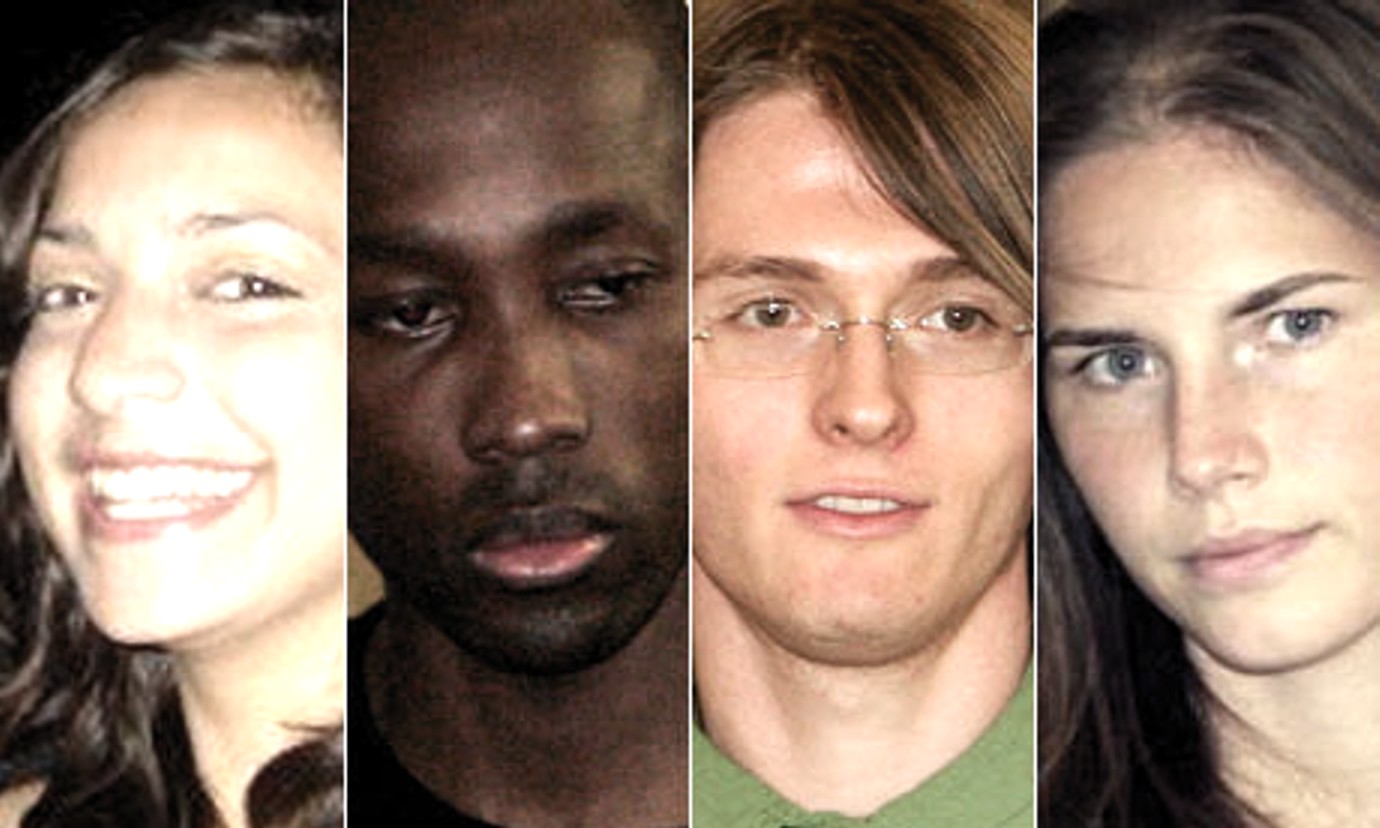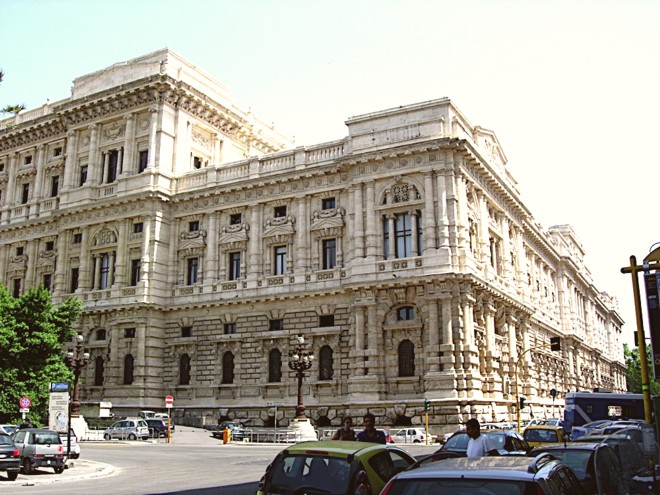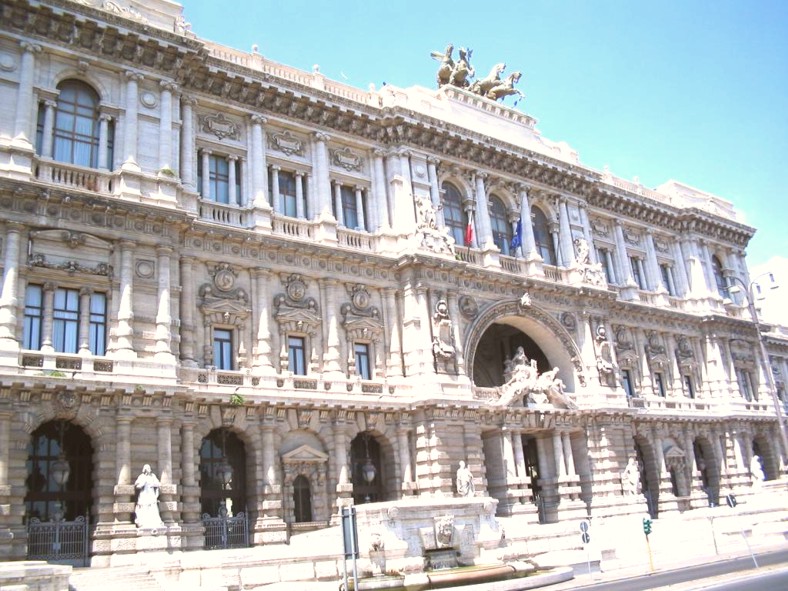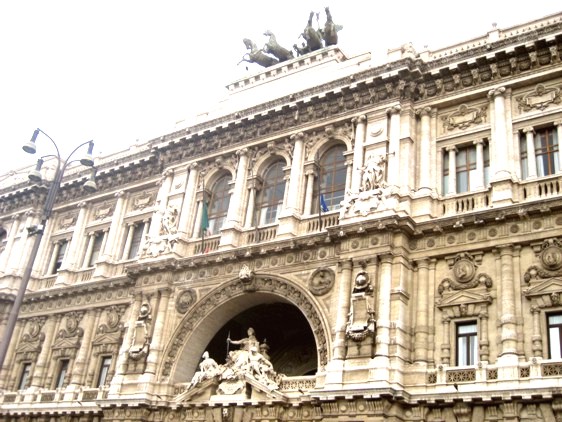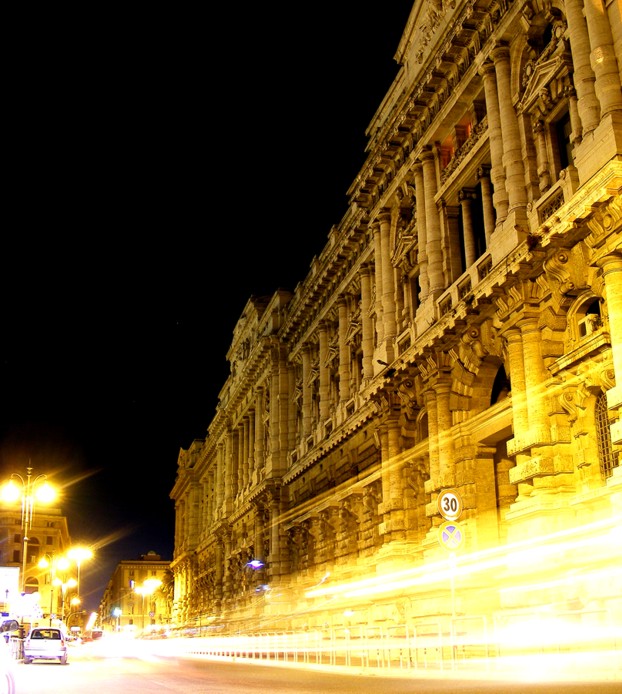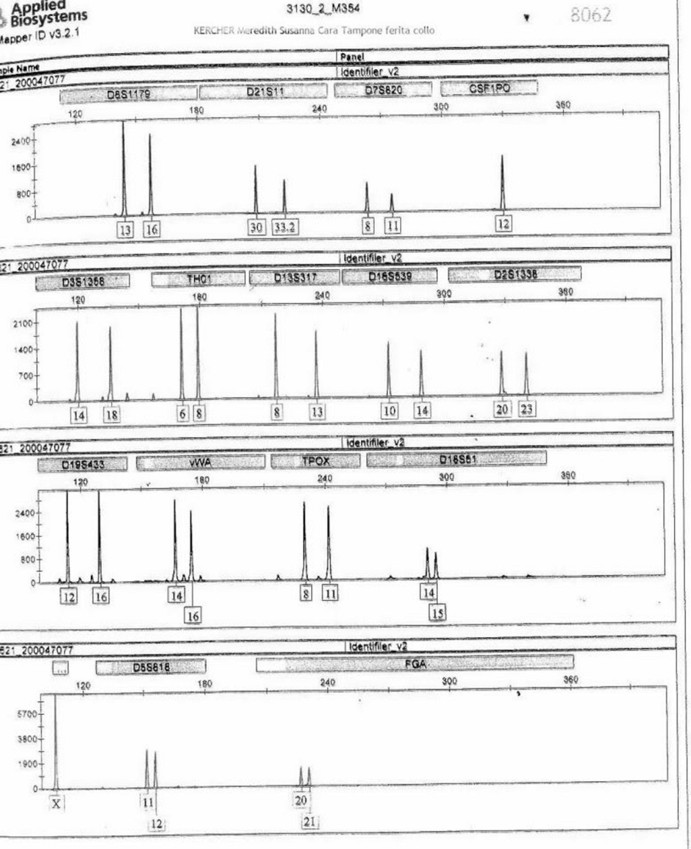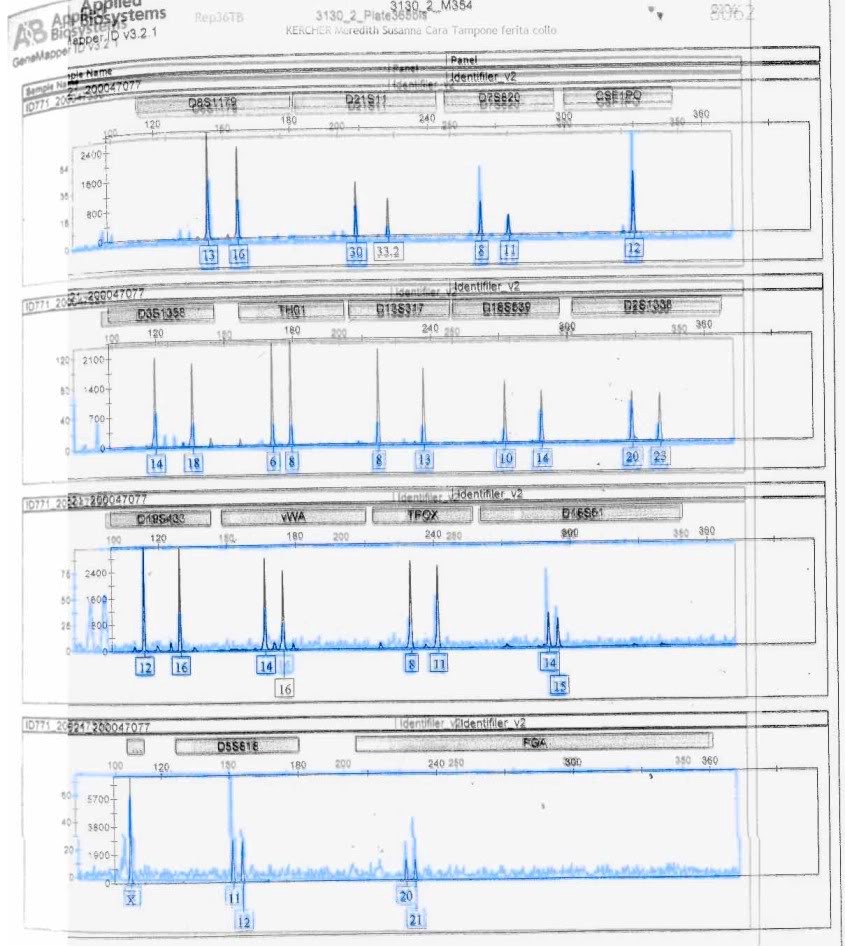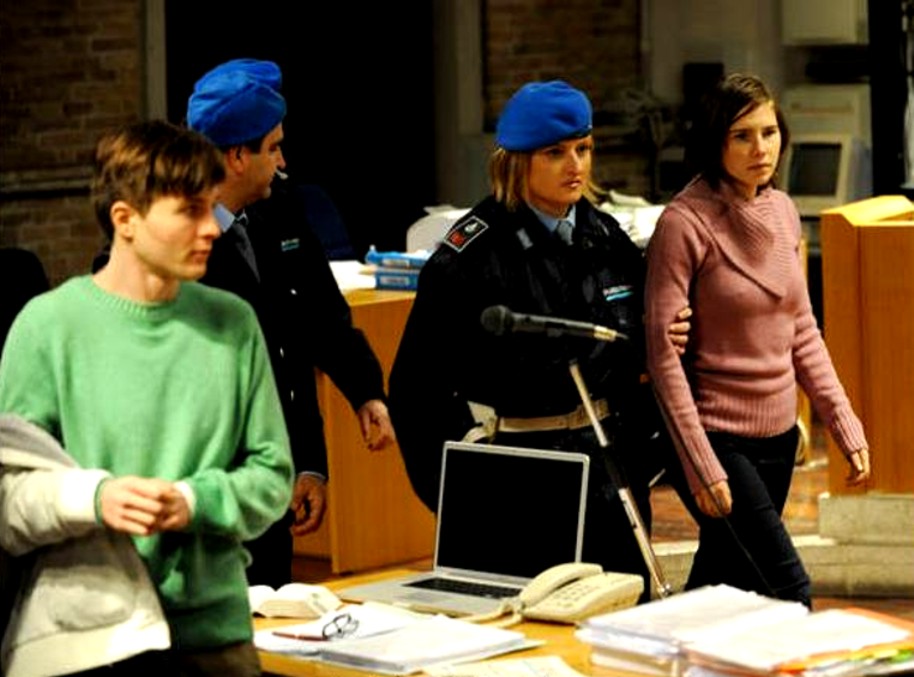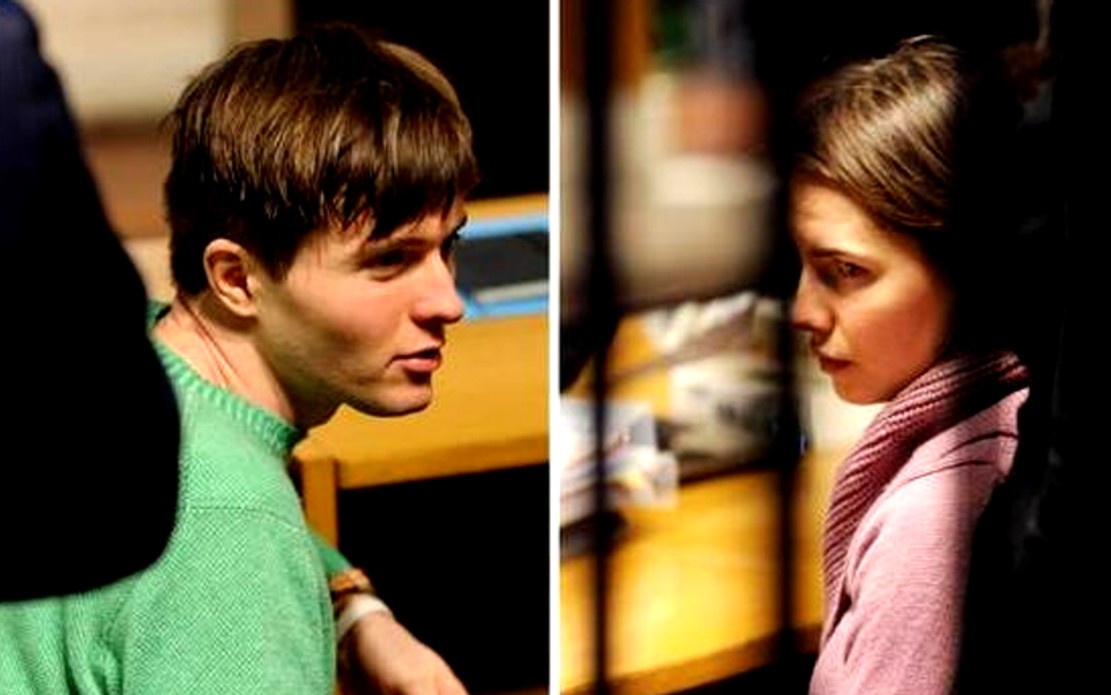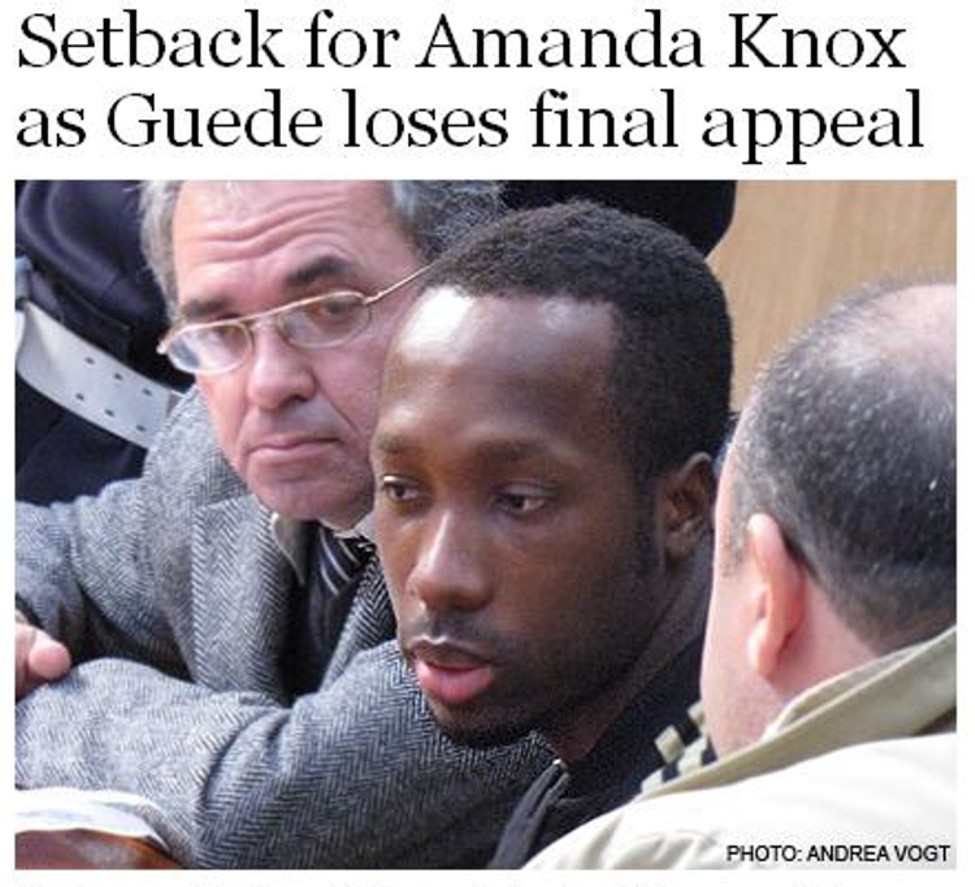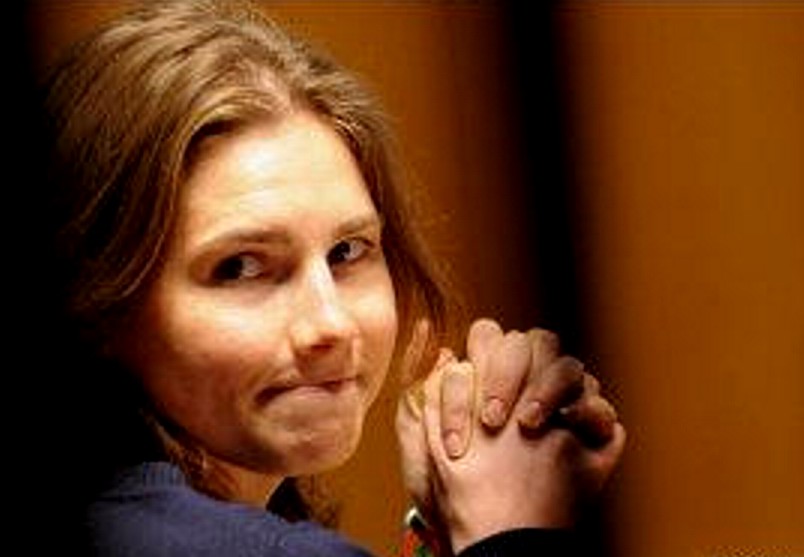
Category: Appeals 2009-2015
Monday, February 28, 2011
Andrea Vogt: Supreme Court Report Highlights Amanda Knox Mention To Mom She Was There
Posted by Peter Quennell
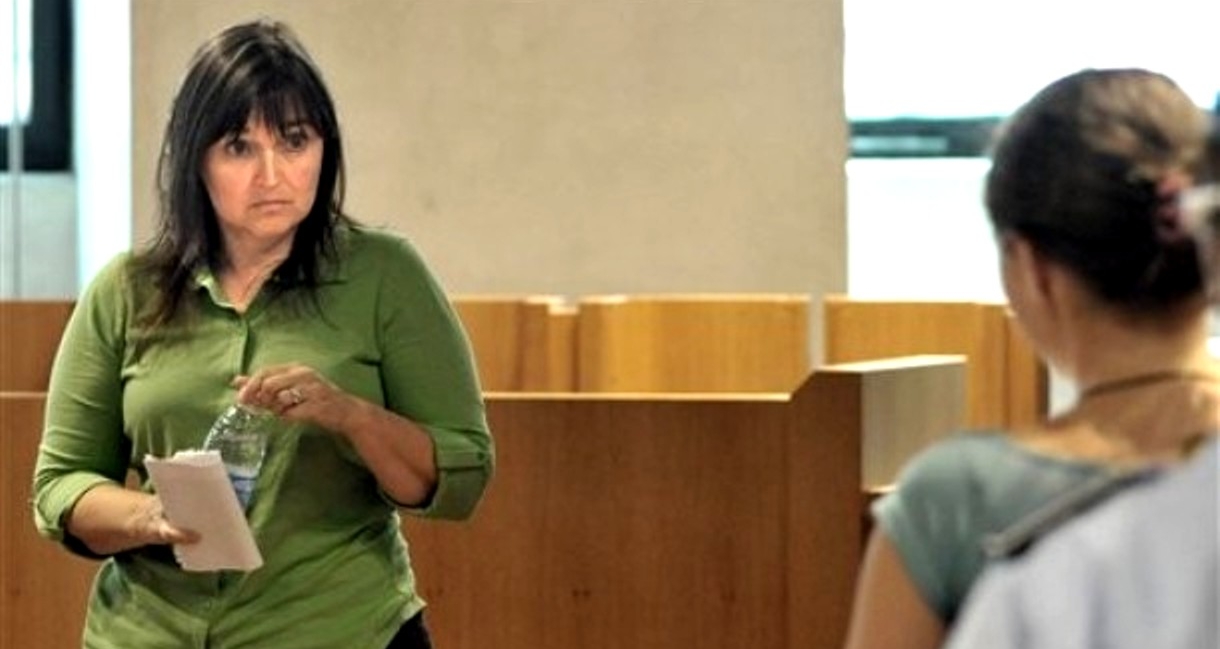
[Above: Amanda Knox and her mother in courtroom when Edda Mellas testified 19 July 2009]
Andrea Vogt in the Seattle PI translates from the Cassation Report described in our two previous posts.
A sentencing report just released by the highest Italian appeals court sheds new light on why so many Italian judges have maintained Amanda Knox was involved in her roommate’s murder.
The document, among others, cites a conversation Knox had with her parents while under surveillance during a prison visit in which she said “I was there,” apparently referring to the night of the murder.
Amanda Kox’s remark was recorded at Capanne Prison and was long public knowledge, but that the Supreme Court listed it among other evidence of involvement in this report is significant. The report summarises what is the evidence against all three, especially that against Rudy Guede.
The court…said that based on the 43 wounds to Kercher’s body (and the time it would take to inflict them) that it was… probable that Guede and two others forcibly held Kercher down, threatened, taunted and eventually fatally stabbed her.
The Court’s quoted language is extremely hard and gives a sense that the judges were appalled. The Court’s report has been out in Italy for over four days now - but the Seattle PI’s is the first extensive US or UK media summary.
The US and UK media have a pretty consistent habit of ignoring these inconvenient reports.
Saturday, February 26, 2011
Very Hard Language Of Supreme Court In Rejecting Guede Appeal, Confirming Three Did It
Posted by Peter Quennell
The report of the Supreme Court of Cassation released on Thursday was foreshadowed in content in our post of 17 December:
Rudy Guede’s appeal is rejected on all ten grounds. His appeal grounds were ugly and dishonest and he has no further appeal. He will serve his 16 years, with maybe some time off, for being a savage willing party to the cruel stupid murder of Meredith.
Rudy Guede will go down in infamy for his sex crime against a defenseless victim, for being a party to a taunting torturing knife attack, for claiming Meredith invited him in for consensual sex, and for not calling for help for Meredith and maybe saving her life while it was still possible.
Cassation continues the fine Italian court tradition in this case of taking a firm and unblinking position, and for being utterly oblivious to the vile over-the-top campaign of Curt Knox, Edda Mellas and David Marriott which may now haunt Amanda Knox all of her life.
What really caught the Italian media’s attention and made this the second most widely reported development in the case after the Amanda Knox-Raffaele Sollecito verdict was the icy hard language, the pure contempt for the depraved pack attack, the total rejection of all Guede’s stories, including his oft-repeated and totally unbelievable claim that Meredith invited him in and wanted love-making, and the court’s conclusion once again that the evidence methodically described in the Micheli Report overwhelmingly proves that THREE perpetrators took part in the crime.
The Court of Cassation in this report made clear that Knox and Sollecito are not already formally nominated as the other two perpetrators and it does wait the referral of the outcome of the present appeal in Perugia. But unless the defense witnesses Alessi and Aviello can indeed convince Judge Hellman’s appeal court that Guede attacked Meredith with friends or that some other people entirely carried out the attack, there seems no way out for them.
The court also indicated that it considered the motive of the attack on Meredith to be frivolous, which is precisely what the prosecution claims in the current Perugia appeal as grounds for rejecting Massei’s mitigating circumstances, and for increasing Knox’s and Sollecito’s prison sentences to life terms.
This post of a month ago further explains Knox’s and Sollecito’s almost insurmountable problems.
The written report from Cassation on that December 2010 decision on Guede’s final appeal (due soon), plus Judge Micheli’s Sentencing Report for Rudy Guede of January 2009, plus all that associated evidence, now gets automatically ported by law straight into Knox’s and Sollecito’s appeal.
Judge Micheli took a hard line toward Rudy Guede, and he sentenced him to 30 years. He also remanded Knox and Sollecito to trial, and his report explains the basis for that remand.
Judge Micheli’s remorseless and tightly argued report (see summaries below) very comprehensively backed up his decisions. (Later reductions in sentence were automatic and they flowed from the terms of Guede’s short-form trial, and some controversial mitigating circumstances advanced by Massei for Knox and Sollecito.)
The prosecution’s appeal against the Knox and Sollecito sentences argues that the acceptance of mitigating circumstances by the Massei court should be thrown out, and that Knox and Sollecito should be subjected to a longer sentence. Remember that even in the case of Alessi’s wife, who was not even present when he beat the kidnapped baby to death, she received a sentence of 30 years.
So here is how it is stacking up:.
For the prosecution, four courts including the Supreme Court of Cassation have ruled that three people participated in the crime against Meredith, plus all of the evidence from both the Guede and Knox Sollecito trials now comes in, plus the prosecution is appealing for tougher sentences, which seems well justified based on precedents.
And for the defenses? Will they now feel they have no choice but to put Knox or Sollecito or Alessi or Aviello or for that matter Rudy Guede on the stand as a last-ditch manoeuvre?
Hard to see what further they have to lose.
Thursday, January 20, 2011
The New 80,000 Pound Gorilla In The Room Introduced By The Italian Supreme Court
Posted by Our Main Posters

[St Peter’s and the Vatican in background; Palace of Justice, large white building by river in left foreground]
What is the biggest headache for the defenses?
That their areas of appeal, already circumscribed by Judge Hellman, could all explode in their faces? The low-credibility witnesses Alessi and Aviello? The limited DNA retesting? The re-examination of the witness in the park who had no cause to make anything up?
Or that Rudy Guede gets totally ticked off by Alessi’s claims that Rudy Guede said he did it with one or two others, and so Guede tells the court all that REALLY happened?
No, it looks to us that the defenses’ biggest headache by far is that the court of final appeal in Rome (the Supreme Court of Cassation, which is superior to the Perugia appeals court and will hear the second and final appeal) has ALREADY accepted that Rudy Guede’s sentencing report of January 2009 holds up.
And that all three of them attacked Meredith.
The written report from Cassation on that December 2010 decision on Guede’s final appeal (due soon), plus Judge Micheli’s Sentencing Report for Rudy Guede of January 2009, plus all that associated evidence, now gets automatically ported by law straight into Knox’s and Sollecito’s appeal.
Judge Micheli took a hard line toward Rudy Guede, and he sentenced him to 30 years. He also remanded Knox and Sollecito to trial, and his report explains the basis for that remand.
Judge Micheli’s remorseless and tightly argued report (see summaries below) very comprehensively backed up his decisions. (Later reductions in sentence were automatic and they flowed from the terms of Guede’s short-form trial, and some controversial mitigating circumstances advanced by Massei for Knox and Sollecito.)
The prosecution’s appeal against the Knox and Sollecito sentences argues that the acceptance of mitigating circumstances by the Massei court should be thrown out, and that Knox and Sollecito should be subjected to a longer sentence. Remember that even in the case of Alessi’s wife, who was not even present when he beat the kidnapped baby to death, she received a sentence of 30 years.
So here is how it is stacking up:.
- For the prosecution, four courts including the Supreme Court of Cassation have ruled that three people participated in the crime against Meredith, plus all of the evidence from both the Guede and Knox Sollecito trials now comes in, plus the prosecution is appealing for tougher sentences, which seems well justified based on precedents.
- For the defenses, just those few areas the defenses want to challenge which have been allowed by Judge Hellman NONE of which are sure things.
Really not very much going for the defenses here. No wonder they already seem to be phoning it in.
Our meticulous summaries of the Micheli Report by main posters Brian S and Nicki were based on our own translation. A huge amount of work. They were posted nearly two years ago. Periodically we link to them in other posts or we point to them in an email.
Those who do read those posts fresh are often stunned at their sharpness, and for many or most it becomes case closed and the verdict of guilty is seen as a fair one.
We think those posts on Micheli are so key to a correct grasp of Knox’s and Sollecito’s appeal prospects that they should now be reposted in full.

[St Peter’s and the Vatican in foreground; Palace of Justice, large white building in left background]
Understanding Micheli #1: Why He Rejected All Rudy Guede’s Explanations As Fiction
By Brian S
Judge Micheli has had two very important roles. He presided over Rudy Guede’s trial and sentencing, and he presided over the final hearing that committed Raffaele Sollecito and Amanda Knox to trial.
A week ago, just within the three-month deadline, Judge Micheli made public the 106-page report that explains the thinking behind both actions. This is a public document, and in the enviable Italian legitimizing process, the public is encouraged to get and read the report and to understand the full rationales. Excellent analyses have already appeared in Italian in Italy, but no English-speaking sources on the facts of the case have either put the report into English or published more than the most superficial analysis.
These posts will examine several very key areas of the report so that we too may choose whether to buy into the rationales. The translations into English here were by native-Italian speakers and fellow posters Nicki and Catnip. The next post will explain why Micheli ruled out the Lone Wolf Theory, and why he concluded that Knox and Sollecito appeared to be implicated in Meredith’s murder and should therefore be sent to trial.
Judge Micheli maintained that from the moment Meredith’s body was discovered until his arrest in Germany on November 19th, Rudy Guede was in a position to compile a version of his involvement in events at the cottage which would minimise his reponsibilities and point the finger of guilt elsewhere.
He was able to follow the course of the investigation in newspapers and on the internet. He would know of the arrests of Amanda, Raffaele and Patrick. He would know that the investigators had found biological evidence which would sooner or later connect him to the murder, and he would know of other discoveries and evidence which had been publicised in the media.
His story as told in Germany was compiled with all the knowledge about the crime and investigation he would have sought out. On his return to Italy in December he was interviewed by the investigating authorities and gave version 2. He was interviewed again in March which resulted in version 3, and later still made a spontaneous statement to change one or two facts including the admission that the trainer footprint in Meredith’s room could be his. Judge Micheli said:
- Analyzing the narratives of the accused…he is not credible, as I will explain, because his version is (1) unreliable, and (2) continuously varying, whether on basic points or in minor details and outline.
Micheli then examined the details of Rudy’s claimed meeting with Meredith which resulted in his invitation to the cottage on the evening of November 1st.
He noted there were substantial differences between his versions of December and March, particularly with regard to the location of his meeting with Meredith on the night of Halloween and his movements in the early evening of November 1st.
He considered it likely that Rudy had made these changes as he became aware of evidence which contradicted his December version. Notably, in December Rudy claimed to have had his meeting with Meredith which resulted in her invite at a Halloween party given by Spanish students.
By March it was well known that Meredith had spent her entire Halloween in the company of friends, first in the Merlin pub before they later moved on to Domus disco. In March Rudy changed the location of his meeting with her from the Spanish party to Domus, which by chance Rudy had also attended following the party. However, neither Meredith’s friends who were continuously in her company nor those who accompanied Rudy to the Domus witnessed any meeting between the two. Judge Micheli commented:
- On 26 March 2008, instead, Rudy explained to the Prosecution, drawing a picture, that the group invited to the Spaniards’ house actually moved wholus-bolus to the “Domus” club, but it was right in that nightclub that he met Kercher, and not before; offering up a tour-guide description from the chair, saying, “there’s a bar for the drinks and then there’s a room, there’s an arch and a room. I walking [sic] around there, and that’s where I met Meredith”. On the facts of the meeting and the subject of the conversation, he elaborated: “I started talking to Meredith “¦talking anyway I gave her a kiss.. after which I told her how much I liked her and asked her if the next day, in all the confusion anyway, if we were going to meet the next day and she said yes (”¦), we met in the evening around half eight, like that.
While not intending to explore the question, basically irrelevant, of whether the pair had agreed to a more or less specific time (his confirmation of the suggestion of 8.30 pm in both verbal statements however allows the inference that according to Guede they had an appointment), the patent contradiction between the two versions jumps out. One context, of a room between two bathrooms, in an apartment, is completely different to that of a drinks-bar and an arch, in a pub; one might concede, perhaps, the possibility of forgetting which place it was where they last bumped into a friend, but hardly the first time there was a kiss with a girl towards whom one was attracted.
With regard to his movements in the early evening of November 1st, Rudy’s friend Alex failed to corroborate Rudy’s December claim to have visited his flat. He said he didn’t see Rudy either before or after his meeting with Meredith at her cottage.
In March, Rudy changed his story and claimed to have risen at 6pm(following the all-nighter at Domus) before wandering around town for an hour or so. He then said he went to Meredith’s cottage but received no answer so he carried on to Piazza Grimana in the hope he might see people he knew. He thought he arrived in the Piazza at around 7:30pm. He claimed that some time later he left Piazza Grimana and called at the Kebab shop before returning to Meredith’s cottage and arriving some time between 8:30 and 9:00pm.
He said he then waited until her arrival some time just after 9:00pm. It was noted that in both his December and March versions Rudy said he had arranged to meet Meredith at 8:30pm. Micheli noted that this didn’t sit well with another arrangement Rudy had made to meet Carlos (from the Spanish party) between 9:00 and 10:00pm.
Micheli said that neither version of Rudy’s movements could be treated as true because he changed his story to fit facts as they became known and there was absolutely no corroborating witness evidence.
Rudy claimed two situations evolved following his entry with Meredith into the apparently empty cottage:
Whilst he was having a drink of fruit juice from the fridge, he claims Meredith found that 300 euros (her rent money) was missing from her bedside cabinet. Meredith was naturally upset by this discovery and straight away blamed “druggy Amanda”. Rudy said they both checked Amanda’s room to see if the money was there. However, it couldn’t be found and Rudy sought to console her.
He says that this consolation developed into an amorous encounter which proceeded to the stage where “Meredith asked him” if he had a condom. He told he didn’t and since she didn’t either they stopped their lovemaking.
Judge Micheli had a real problem with this story as told by Guede. He found it unlikely that Meredith would be interested in lovemaking so soon following the discovery that her money was missing. He found it unlikely that it was Meredith who was leading the way in this amorous encounter as Rudy was suggesting with his claim that it was “Meredith who asked him” if he had a condom.
Surely, Micheli reasoned, if Rudy was hoping to indulge in a sexual encounter with Meredith following the previous night’s flirting, he would, as any young man of his age, ensure that he arrived with a condom in anticipation of the hoped for liason. But even if he didn’t, and it was true that events had reached the stage where Meredith asked him, then surely given his negative response, Meredith would have again gone into Amanda’s room where, as she had told her friends, condoms were kept by her flat mate. Judge Micheli simply didn’t believe that if they had got to the stage of lovemaking described by Rudy, and following his negative response to her question, they just “STOPPED”. Meredith would have known she had a probable solution just metres away.
Rudy claimed he then told Meredith he had an upset stomach because of the kebab he had eaten earlier. She directed him to the bathroom through the kitchen.
Rudy put on his i-pod and headphones as he claimed was his habit when using the toilet. In his December version Rudy said the music was so loud he heard the doorbell ring but he made no reference to hearing any conversation. A perfect excuse, Judge Micheli says, for not hearing the disturbance or detail of Meredith’s murder. However, in his March version he claims he heard Amanda’s voice in conversation with Meredith. When Rudy did eventually emerge from the bathroom he says he saw a strange man with a knife and then a prone Meredith. Micheli commented:
- ...it is necessary to take as given that, in this case, Kercher did not find anything better to do than to suddenly cross from one moment of tenderness and passion with him to a violent argument with someone else who arrived at that place exactly at the moment in which Rudy was relieving himself in the bathroom. In any case, and above all, that which could have been a surprise to the killers, that is to say his presence in the house, was, on the other hand, certainly not put into dispute:
Meredith, unlike the attackers, knew full well that in the toilet there was a person who she herself allowed in, so for this reason, in the face of someone who had started raising their voice, then holding her by the arms and ending with brandishing a knife and throwing her to the floor, why would she not have reprimanded/reproached/admonished him immediately saying that there was someone in the house who could help her?
“¦Meredith didn’t shout out loudly for Rudy to come and help
“¦There was a progression of violence
“¦The victim sought to fight back
If it is reasonable to think that a lady living 70 metres away could hear only the last and most desperate cry of the girl ““ it’s difficult to admit that Guede’s earphones, at 4-5 metres, would stop him hearing other cries, or the preceding sounds.
Micheli was also mystified as to why Amanda (named in Rudy’s March version) would ring the doorbell. Why wouldn’t she let herself in using her own key? He supposed it was possible Meredith had left her own key in the door which prevented Amanda from using hers, but the girls all knew the lock was broken and they were careful not to leave their own key in the door. Perhaps, Meredith wanted some extra security/privacy against someone returning and had left her key in the lock on purpose. Maybe Amanda was carrying something heavy and her hands weren’t free. Or, maybe, Rudy was just trapped by his December story of the doorbell when he didn’t name anybody and an anonymous ring on the doorbell was plausible.
The judge then took issue with Rudy’s description of events following the stabbing of Meredith. Rudy claimed that when he emerged from the bathroom he discovered a man with a knife standing over Meredith. In the resultant scuffle he suffered cut wounds to his hand. armed himself with chair to protect himself. before the attacker fled when he fell over because his trousers came down around his ankles. Micheli said that those who saw Rudy later that night didn’t notice any wounds to Rudy’s hands although some cuts were photographed by the police when he was later arrested in Germany.
Micheli found Rudy’s claim that the attacker ran from from the house shouting “black man found, black man guilty” unbelievable in the situation. In the panic of the moment it may be conceivable that the attacker could shout “Black man…, run” following the surprise discovery of his presence in the house, but in the situation Rudy describes, blame or expressions of who the culprit thought “the police would find guilty” made no sense. It would be the last thing on an unknown attackers mind as he sought to make good his escape.
Micheli considers the “black man found, black man guilty” statement an invention made up by Rudy to imply a possible discrimination by the authorities and complicate the investigation. Micheli also saw this as an excuse by Rudy to explain away his failure to phone for help (the implication being that a white man could have made the call). It was known by her friends and acquaintances that Meredith was never without her own phone switched on. She kept it so, because her mother was ill and she always wanted to be available for contact should her mother require help when she was on her own
Judge Micheli regarded Rudy’s claimed efforts to help Meredith impossible to believe, given the evidence of Nara Capezzali. Rudy claimed to have made trips back and forth to the bathroom to obtain towels in an attempt to staunch the flow of bood from Meredith’s neck. He claimed to have leaned over her as she attempted to speak and written the letters “AF” on the wall because he couldn’t understand her attempted words. His described activities all took time and Rudy’s flight from the house would have come minutes after the time he alleged the knife-man ran from the cottage.
Nara Capezzali maintained that after she heard Meredith’s scream it was only some seconds (well under a minute) before she heard multiple footsteps running away. Although she looked out of her window and continued to listen for some time because she was so disturbed by the scream, she neither heard nor saw any other person run from the house. That Rudy had run wasn’t in doubt because of his collision on the steps above with the boyfriend of Alessandra Formica. Micheli therefore considered it proven that “all” of Meredith’s attackers, including Rudy, fled at the same time.
Earlier in his report Micheli considered character evidence on Rudy given by witnesses for both prosecution and defense. Although he had been seen with a knife on two occasions, and was considered a bit of a liar who sometimes got drunk, the judge didn’t consider that Rudy had previously shown a propensity for violence, nor behaviour towards girls which differed markedly from that displayed by many other young men of his age.
However, because of the wealth of forensic evidence [on which more later] and his admitted presence in the cottage, combined with his total disbelief in Rudy’s statements, Micheli found Rudy guilty of participation in the murder of Meredth Kercher.
He sentenced him to 30 years in prison and ordered him to pay compensation of E2,000,000 each to Meredith’s parents John and Arline Kercher, E1,500,000 each to Meredith’s brothers John and Lyle Kercher plus E30,000 costs in legal fees/costs + VAT. Also E1,500,000 plus E18,000 in legal fees/costs + VAT to Meredith’s sister, Stephanie Kercher.
Understanding Micheli #2: Why Judge Micheli Rejected The Lone-Wolf Theory
By Brian S
And so decided that Raffaele Sollecito and Amanda Knox should face trial.
First, just to recap: Judge Micheli presided over both Rudy Guede’s trial and sentencing to 30 years and the final hearing that committed the two present defendants to trial.
Ten days ago, Judge Micheli made public the 106-page report that explains the thinking behind both actions. This is a public document, and in the enviable Italian legitimizing process, the public is encouraged to get and read the report and to understand the full rationales. Excellent analyses have already appeared in Italian in Italy, but no English-speaking sources on the facts of the case have either put the report into English or published more than the most superficial analysis.
These posts are examining several very key areas of the report so that we too may choose whether to buy into the rationales. The translations into English used here were by native-Italian speakers and fellow posters Nicki and Catnip.
Right at the outset of his Sentence Report on the conviction of Rudy Guede, Judge Micheli stated that it was neither the place nor his intention to make the case against either Raffaele Sollecito or Amanda Knox. He said he must necessarily involve them to the extent that they were present at the discovery of Meredith’s body. He said he must also examine evidence against them where he saw it as indicating that Rudy Guede was not a lone wolf killer and implicated them as his possible accomplices in Meredith’s murder.
Judge Micheli described the sequence of events laid out by the prosecution which lead to the discovery of Meredith’s body:
Early on the morning of November 2nd, Signora Lana Biscarini received a bomb threat call made to her home at 5A Via Sperandio. (This later transpired to be a hoax.)
Some time later Signora Biscarini found a mobile phone in her garden. She “had heard” that bombs could be concealed in mobile phones and so she took it to the police station arriving at 10:58am as recorded by ISP. Bartolozzi
The postal police examined the phone and following removal of the SIM card, discovered at 11:38am that it belonged to a Filomena Romanelli who lived at the cottage at 7 Via della Pergola. Following a call by Signora Biscarini to check with her daughter who was still at home, it is in the record at 11:50am that neither say they know the Filomena in question. At around noon Signora Biscarini’s daughter rings her mother at the police station to say she has found a second phone.
The second phone (Meredith’s) is collected from Via Sperandio and taken to the police station. Its receipt there is logged by ISP. Bartolozzi at 12:46pm. During its examination Meredith’s phone is also logged as connecting to the cell of Strada Borghetto di Prepo, which covers the police station, at 13:00pm. At 13:50pm both phones, which have never left the police station following their finding, are officially seized. This seizure is entered in the log at 14:00pm.
Separately, as part of the bomb hoax investigation, agents of the postal police are dispatched to make enquiries at Filomena’s address in Via della Pergola.
They are recorded in the log and filmed on the car park camera as arriving at 12:35pm. They were not in possession of Filomena’s phone, which remained at the police station, nor of Meredith’s which at this time was being taken from Via Sperandio to the police station for examination as part of the bomb hoax enquiry.
Judge Micheli said that some confusion was created by the evidence of Luca Altieri (Filomena’s boyfriend) who said he saw two mobile phones on the table at the cottage. But, Micheli said, these two phones either belonged to the others who arrived, the postal police themselves or Amanda and Raffaele. They were NOT the phones of Filomena or Meredith.
On their arrival at the cottage, the agents of the postal police found Raffaele Sollecito and Amanda Knox standing outside the front door.
The two seemed surprised to see them (the postal police had come to talk to Filomena about a bomb hoax which potentially involved her phone, plus they had recently been informed of the discovery of second phone in the same garden), but then they explained they had discovered suspicious circumstances inside the cottage.
Raffaele said he had already phoned the police and they were awaiting their arrival in connection with that. Elsewhere in his report Micheli points out that Raffaele did, in fact, make a call to his sister at 12:50pm, followed by two calls to “112” reporting a possible burglary at 12:51 and 12:54pm, 15 minutes after the arrival of the postal agents.
Judge Micheli said the postal police were shown into the cottage by Raffaele and Amanda. They pointed out the traces of blood around the apartment, the state of the toilet and the disturbance to Filomena’s room. They said they didn’t think anything had been taken. They pointed out that Meredith’s door appeared to be locked, Raffaele said he had tried to open it, but Amanda said Meredith used to lock the door even when she was going to the bathroom to shower.
Shortly afterwards Luca Altieri and Marco Zaroli arrived. Luca said he had just been contacted by his girlfriend Filomena, who in turn had just been contacted by Amanda Knox about the possible break in. A few minutes later, Filomena herself arrived with Paola Grande. Micheli noted that Filomena had immediately contradicted what Amanda had told the postal police and she said that Meredith never locked her door. She also told the postal police that the phone found with a SIM card in her name was in fact Meredith’s 2nd phone, that she had given Meredith the SIM as a present. The postal police said that they didn’t have the authority to damage property and so the decision was made that Luca would break down the door.
This he did. The scene when the door flew open was instantly obvious, blood everywhere and a body on the floor, hidden under a duvet except for a foot and the top of Meredith’s head. At that point ISP Battistelli instantly took charge. He closed the door and forbade anyone to enter the room before contacting HQ.
Following his description of the events which lead to the discovery of Meredith’s body, Micheli then dedicates quite a few pages of his report to detailing the exact locations, positions, descriptions and measurements of all the items, blood stains, pools and spots etc.etc. found in her room when the investigators arrived. He also goes into precise details on the injuries, marks, cuts and bruises etc. which were found by Lalli when he examined Meredith’s body in situ at the cottage before she was moved. Despite their extent, it is obvious these details are only a summary of the initial police report and also a report made by Lalli on the 2nd November.
It is these details which allowed the prosecution to lay out their scenario for the events which they say must have happened in the room. It is also these details which convince Micheli that it was impossible for this crime to be carried out by a single person. In his report, he dismisses completely the scenarios presented by the defences of Amanda and Raffaele for a “lone wolf killing”. Micheli says that he is convinced that Meredith was sexually assaulted and then murdered by multiple attackers.
Judge Micheli also explains in his report how the law will decide on sexual assault or rape where the medical report (as was Lalli’s) is somewhat inconclusive. Else there would be no point in a woman reporting rape unless she had serious internal injuries. His conclusion: Meredith was raped by Rudy Guede manually.
So why does Judge Micheli believe that Amanda Knox and Raffaele Sollicto were possible accomplices of Rudy Guede and should be tried for the murder of Meredith Kercher?
In his report, he doesn’t look at the evidence which involves just them, nor does he analyze their various stories in his report. He doesn’t look at events involving them which occurred between the 2nd and 5th November. He does note a few items here and there, but these aren’t given as the major reasons for his decision to indict them.
He notes Raffaele’s apparent lies about the time he made the 112 phone calls. He dismisses Raffaele’s defense claim that the disposal of Meredith’s phones didn’t allow time for Raffaele to get to the cottage after watching his film, kill Meredith, and then dispose of the phones in Via Sperandio before the aborted call to Meredith’s bank. He noted that the cell which picked up the brief 10:13 call to Meredith’s bank also picked up most of Meredith’s calls home.
He asked whether it was possible for anybody to believe that each time Meredith wanted to phone home, she walked down to Via Sperandio to make the call. He notes that the police found Amanda and Raffaele’s behaviour suspicious almost straight away. He notes that Filomena said that the relationship between Amanda and Meredith had deteriorated by October. He says he doesn’t believe at all that cannabis caused any loss of Amanda’s and Raffaele’s memories.
Judge Micheli says he bases his decision on the following points of evidence:
[Note: The following paragraph numbers form no part of Micheli’s report. They are used in the context of this summary to identify the points of evidence contained in his report which will be examined and summarised in greater detail in follow-up posts]
1) Judge Micheli, after hearing both prosecution and defense arguments about Meredith’s and Amanda’s DNA on the knife and Raffaele’s DNA on Meredith’s bra clasp, accepted the prosecution argument that that both were valid evidence. He did note, however, that he fully expected that the same argument would be heard again at the full trial. In his report, Micheli dedicates several pages to explaining the opposing arguments and how he made his decision to allow the evidence. It is a detailed technical argument, and it is not proposed to examine it any closer in this post.
2) Judge Micheli explains that blood evidence proves that Meredith was wearing her bra when she was killed. Nor is it just the blood on her bra which demonstrates this. It’s also where the blood isn’t on her body. He says that Meredith was wearing her bra normally when she laid in the position in which she died, and she was still wearing it for quite some time after she was dead. Her bra strap marks and the position of her shoulder are imprinted in the pool of blood in that position. Meredith’s shoulder also shows the signs that she lay in that position for quite some time.
He asks the question: Who came back, cut off Meredith’s bra and moved her body some time later? It wasn’t Rudy Guede. He went home, cleaned himself up and went out on the town with his friends. Judge Micheli reasons in his report that it could only have been done by someone who knew about Meredith’s death and had an interest in arranging the scene in Meredith’s room. Seemingly who else but Amanda Knox?
She was apparently the only person in Perugia that night who could gain entry to the cottage. And the clasp which was cut with a knife when Meredith’s bra was removed was found on November 2nd when Meredith’s body was moved by the investigators. It was right under the pillow which was placed under Meredith when she was moved by someone from the position in which she died. On that clasp and its inch of fabric is the DNA of Raffaele Sollecito and Amanda Knox. Micheli reasons in his report that Raffaele and Amanda seemed to have returned to the cottage some time after Meredith was dead, cut off her bra, moved her body, and staged the scene in Meredith’s room.
3) Judge Micheli explains his reasoning on the method of Rudy’s entry into the cottage. He says that Rudy’s entry through the window is a very unlikely scenario and the evidence also indicates otherwise. He says the height and position of the window would expose any climber to the full glare of traffic headlights from cars on Via della Pergola. He asks, why wouldn’t a thief choose to break in through a ground floor window of the empty house? He says the broken glass and marks on the shutter both demonstrate the window was broken from the inside, some of the glass even falling on top of Filomena’s clothes which had been thrown around the room to simulate a robbery.
But his major reasoning for believing Rudy’s entry was through the front door are the bloody bare footprints which show up with luminol and fit Knox’s and Sollecito’s feet. These suggest that they entered Filomena’s room and created the scene in there after Meredith was killed. Allessandra Formica witnessed Rudy run away shortly after Meredith was stabbed. Someone went back later, left those footprints and staged the scene.
This, when considered in combination with the knowledge that person demonstrated of Rudy’s biological involvement with Meredith when they also staged the sex assault scene in Meredith’s own room indicates that that person was present when Meredith was assaulted and killed. He said it also demonstrated an attempt by someone who had an interest in altering the evidence in the house to leave the blame at Rudy’s door. Micheli reasoned, the only person who could have witnessed Rudy’s earlier sex assault on Meredith, could gain entry via the door and had an interest in altering the crime scene in the house appeared to be Amanda Knox. In his report, Micheli states that this logic leads him to believe that Amanda Knox was the one who let Rudy Guede into the cottage through the front door.
4) Judge Micheli examines the evidence of Antonio Curatolo. He says that although Curatolo mixes up his dates in his statement, he does have a fix on the night he saw Amanda and Raffaele in Piazza Grimana sometime around 11:00 to 11:30pm. Curatolo is certain it was the night before the Piazza filled up with policemen asking if anyone had seen Meredith. In his evidence, he says they came into the square from the direction of Via Pinturicchio and kept looking towards the cottage at Via della Pergola from a position in the square where they could see the entrance gate.
Judge Micheli reasons in his report that their arrival from Via Pinturicchio ties in with the evidence from Nara Capazzali that she heard someone run up the stairs in the direction of that street. He also reasons that they were likely watching the cottage to see if Meredith’s scream had resulted in the arrival of the police or other activity.
5) Judge Micheli examines the evidence of Hekuran Kokomani and finds him far from discredited. His says the testimony is garbled, his dates and times makes no sense but…. that Hekuran Kokomani was in the vicinity of the cottage on both 31st Oct. and 1st Nov isn’t in doubt. Furthermore, Micheli says that when he gave his statement, the details which he gave of the breakdown of the car, the tow truck and the people involved weren’t known by anyone else. He must have witnessed the breakdown in Via della Pergola. The same breakdown was also seen by Allessandra Formica shortly after Rudy Guede collided with her boyfriend.
This places Hekuran Kokomani outside the cottage right around the time of Meredith’s murder and he in turn places Raffaele Sollecito, Amanda Knox and Rudy Guede together outside the cottage at the same time. His evidence also places all three outside the cottage at some time the previous night.
Judge Michelii found that all this evidence implicated Amanda Knox and Raffaele Sollecito as accomplices of Rudy Guede in the murder of Meredith Kercher.
Understanding Micheli #3: How Damning Is The DNA Evidence Coming Up?
By Nicki
Probable answer? Pretty damning.
Judge Micheli has had two very important roles. He presided over Rudy Guede’s trial and sentencing, and he presided over the final hearing that committed Raffaele Sollecito and Amanda Knox to trial.
Late January, Judge Micheli made public the 106-page report that explains the thinking behind both actions. These posts are examining several very key areas of the report so that we too may choose whether to buy into the rationales.
The trial to establish the truth about the murder of Meredith continues next Friday. As we’ve reported, various human witnesses have already been heard from: the Postal Police who discovered Meredith’s body, Meredith’s two Italian roommates, and her seven British friends.
Coming up soon is a more silent witness, one very important to both the prosecution and the two defenses: the DNA evidence.
Specifically the DNA belonging to Meredith, Knox, Sollecito, and Guede which was found at the scene of the crime, and on the suspected murder weapon found, apparently hidden, in Raffaele Sollecito’s house.
Traces of Meredith’s DNA have been found on a knife compatible with the wounds that caused her death. Amanda Knox “˜s genetic material was identified on the knife handle. DNA belonging to Sollecito has been found on the clasp of the victim’s bra. And more DNA showing Rudy Guede’s genetic profile was found on the victim’s body and elsewhere in the house.
In summary, the biological sources and locations where DNA belonging to the three defendants was found are these:
- Guede’s DNA (from epithelial cells) was found inside Meredith, on toilet paper, on the right side of Meredith’s bra, mixed with Meredith’s DNA on the her purse zip, and on the left cuff of Meredith’s light blue sweater
- Sollecito’s DNA (from epithelial cells) was found on Meredith’s bra clasp, mixed with Meredith’s DNA, and on one cigarette butt found in the kitchen
- Knox’s DNA (from epithelial cells) was found on the knife sheath, and close to the blade junction. It was not possible to ascertain both the haematic and epithelial source of Meredith’s DNA on the knife blade, due to the scarcity of the sample. But Judge Micheli noted that reasonable doubt persist that blood could have been present also.
- Other significant biological traces belonging to Meredith - for example, DNA originating from the blood-trace footprints revealed by luminol found in Filomena’s bedroom, as already reported at trial.
Claims of contamination and “poor matches” of the DNA samples were raised by the Sollecito and Knox defenses, although not by Guede’s. The DNA expert Dr. Stefanoni’s arguments in reply to the defenses’ claims are summarized in Judge Micheli”˜s report.
Dr Stefanoni reported that the locus ascribable to Meredith and identified on the knife blade shows readings of 41 and 28 RFU. Conventionally, RFU values lower than 50 can be defined as low. But she maintained that the profile matched Meredith’s by explaining that there is no immediate correlation between the height of the peaks obtained by electropherogram and expressed in RFU, and the reliability of the biological investigation.
In fact “even if statistically - in most cases - the RFU data is directly proportional to the possibility of a certain interpretation of the analysis result, on the other side many cases of high peaks of difficult interpretation exist (because of background noises), as well as low peaks that are objectively unquestionable, hence the need to proceed to the examination of data that is apparently scarce, but that mustn’t be considered unreliable per se.”
*The use of multiplex PCR and fluorescent dye technology in the automated detection and analysis of short tandem repeat loci provides not only qualitative information about the profile - i.e. which alleles are present - but can provide also quantitative information on the relative intensities of the bands, and is therefore a measure of the amount of amplified DNA.”
So if on one side Dr Stefanoni admits that the RFU readings are low, on the other her experience suggests that many cases of unquestionable matches exist showing readings lower than 50 RFU, and this appears to be the case with Meredith’s DNA sample on the knife.
Contamination in the laboratory is categorically excluded by Dr Stefanoni. The samples were processed with maximum care in order to avoid any contamination during lab procedures. Contamination during the collection phase is excluded by Judge Micheli, as the samples were collected by different officers at different times in different places (example Via della Pergola at 9:40am on Nov 6. 2007, and Sollecito’s apartment at 10:00am, on the same day, by a different ILE team).
As for Sollecito’s DNA found on the bra clasp, the match is unquestionable, according to the lab reports. Samples from crime scenes very often contain genetic material from more than one person (e.g. Rudy Guede’s DNA has been identified in a mixture with the victim’s DNA in a few places), and well-known recommendations and protocols exist in order to de-convolute mixed samples into single genetic profiles.
So if the lab reports indicate that unquestionable biological evidence of Sollecito’s DNA was found on the bra clasp, at the present time we have no reason to believe that these recommendations weren’t followed and that therefore the reports are not to be trusted.
As to cells “flying around” depositing themselves ““ and their DNA content - here and there around the murder scene, there have been some imaginative theories advanced, to say the least.
The reality though is that although epithelial cells do shed, they don’t sprout little wings to flock to one precise spot, nor grow feet to crawl and concentrate on a piece of evidence. There needs to be some kind of pressure on a surface in order to deposit the amount of biological material necessary to yield a reliable PCR analysis result. A simple brushing will not do.
As a matter of fact, Dr Stefanoni agreed with Guede’s defense that Guede”˜s genetic material found on the left sleeve of Meredith’s blouse was minimal; and this was because the DNA found there belonged to the victim and was not a mixture. In the situation where there is a clear disproportion between quantitative data of two DNA’s coexisting in a biological trace, the PCR will amplify the most abundant DNA.
As agreed by Dr. Stefanoni and Guede’s defense, the conclusion here was that on the left sleeve there was plenty of Meredith’s DNA but very little of Guede’s. (This was used by his defense to deny that Guede had exerted violence on Meredith’s wrist).
After listening to the arguments of the prosecution and the defenses, Judge Micheli provided reasons why he rejected the contamination claims and ruled that all the biological traces identified as reflecting Sollecito’s and Knox’s DNA are admissible as evidence. He arrived at the conclusion that the DNA evidence is sound and, considered along with the non-biological proof, he decided there was more than enough evidence to order Knox and Sollecito to stand trial.
Regarding the biological significance of the traces, we are now looking forward to hearing the Knox and Sollecito defenses’ counter-arguments. But as we understand it now, the DNA evidence for the trio having all been involved in the murder seems pretty damning.
Understanding Micheli #4: The Staged Scene - Who Returned To Move Meredith?
By Brian S
Please be warned that this is sad and hard-going, although many other passages from the Micheli report we will never post on here are even more harrowing.
Just to recap. Judge Micheli presided over Rudy Guede’s trial and sentencing and the final hearing that committed Raffaele Sollecito and Amanda Knox to trial.
Late January he made public the 106-page report that explains the thinking behind both actions. These posts are examining key areas of the report so that we too may decide on the rationales.
This post is about the final position of the body. Why this matters so much is that if the evidence holds firm, all by itself it will prove that there was a major rearrangement of the crime scene, to try to throw investigators off the trail.
This is as near to an 80,000 pound gorilla in the room as we are likely to see in this trial. And it may even be on the trial agenda for this coming Friday and Saturday.
Reports by the crime-scene investigators and Dr Lalli are summarised in Judge Micheli’s report. They describe the detail of the scene discovered in Meredith’s room. The investigators measured and photographed the position and state of everything, including blood, as it was in the room before anything was moved.
Amongst the items noted was a white bra. Some parts were soaked in blood, particularly the right shoulder strap and the outside of the left cup. They also noted that a portion of the backstrap with its clasp fixings was missing. Meredith herself was lying on her back midway between the wardrobe and the bed, without her jeans, a pillow under her buttocks and her top rolled up to reveal her chest.
Following this survey, Meredith’s body was then turned and moved by the investigators. This revealed the other items on which her body had lain. A tennis shoe, a white sheet from the bed and a blue zipped top, all with blood stains. Also a green bath towel and an ivory bath towel, both soaked in blood, and underneath the pillow was the missing clasp section of the bra back-strap.
Judge Micheli notes that Amanda’s defence claimed that “the small round spots of blood” apparent on Meredith’s chest indicated that she was not wearing her bra when she was killed. He agreed that it was likely that these spots fell from Meredith’s gasps for breath as she lay on her back after she had been stabbed. However, he could not agree with their conclusion that her bra had been removed before this time, as similar small round spots were also found on Meredith’s bra.
Micheli reasoned that this indicated that Meredith was still wearing her bra as she gasped for breath, but that her top was rolled up and the bra moved also. Thus indicating the sexual nature of the original attack, but also allowing the small round spots to fall on both chest and bra. Furthermore, other blood evidence involving the bra indicated that it wasn’t removed until some time after Meredith had died.
He said that Meredith’s bra was found by investigators away from other possible blood contamination on the floor, near to her feet. Photographs of Meredith’s body show clear white areas where the bra prevented blood from falling onto Merediths body. These white areas corresponded to those areas where blood was found on her bra. This was particularly true in the area of the right shoulder strap which was soaked from the wound to Meredith’s neck.
Micheli said that evidence showed that Meredith had lain on one shoulder near the wardrobe. She lay in that position long enough for the imprint of her shoulder and bra strap to remain fixed in the pool of blood after she was moved to the position in which her body was finally found. Photographs of blood on her shoulder matched the imprint by the wardrobe and her shoulder itself also showed signs that she had remained in that position for some time.
Based on all this, Judge Micheli concluded that there could be no doubt that Meredith’s body was moved away from the wardrobe and her bra removed quite some time after her death.
Neighbor Nara Capezzali had testified that people fled from the cottage within a minute of Meredith’s final scream. There was no time for any alteration of the crime scene in those very few moments.
Judge Micheli asks in his report, who could have returned later and staged the scene which was found? Who later moved Meredith’s body and cut off her bra? He reasons it could only be someone who had an interest in changing what would become a crime scene found at the cottage. Who else but someone who lived there, and who wanted to mislead the coming investigation?
It couldn’t have been Laura, she was in Rome. It couldn’t have been Filomena, she was staying with her boyfriend. It was very unlikely that it was Rudy Guede, all proofs of his presence were left untouched.
The culprits ran from the cottage in different directions and there is no reason to believe they met up again before some or one of them returned. Judge Micheli stated that, in his opinion, this just left Knox who would seem to have an interest in arranging the scene the police would find.
Bloody footprints made visible with luminol in Filomena’s room contain Meredith’s DNA. This indicated to Judge Micheli that the scene in Filomena’s room was also staged after Meredith was killed.
In Micheli’s opinion the scene in Meredith’s room was probably staged to point the finger at Rudy Guede. All evidence related to him was left untouched, and the pillow with a partial palm print was found under Meredith’s repositioned body.
But whoever later arranged that scene in Meredith’s room also unwittingly indicated their own presence at the original sexual assault. Who else could have known that by staging an obvious rape scene, they would inevitably point the investigators towards Rudy’s DNA which they knew could be found in Meredith?
Micheli asks: Seemingly, who else could it have been but Amanda Knox? And this in part is why she was committed to trial, for her defense to contend this evidence.
Monday, December 20, 2010
The Limited DNA Reviews - Why They Probably Won’t Help Defense And May At A Stroke Be Game Over
Posted by The Machine
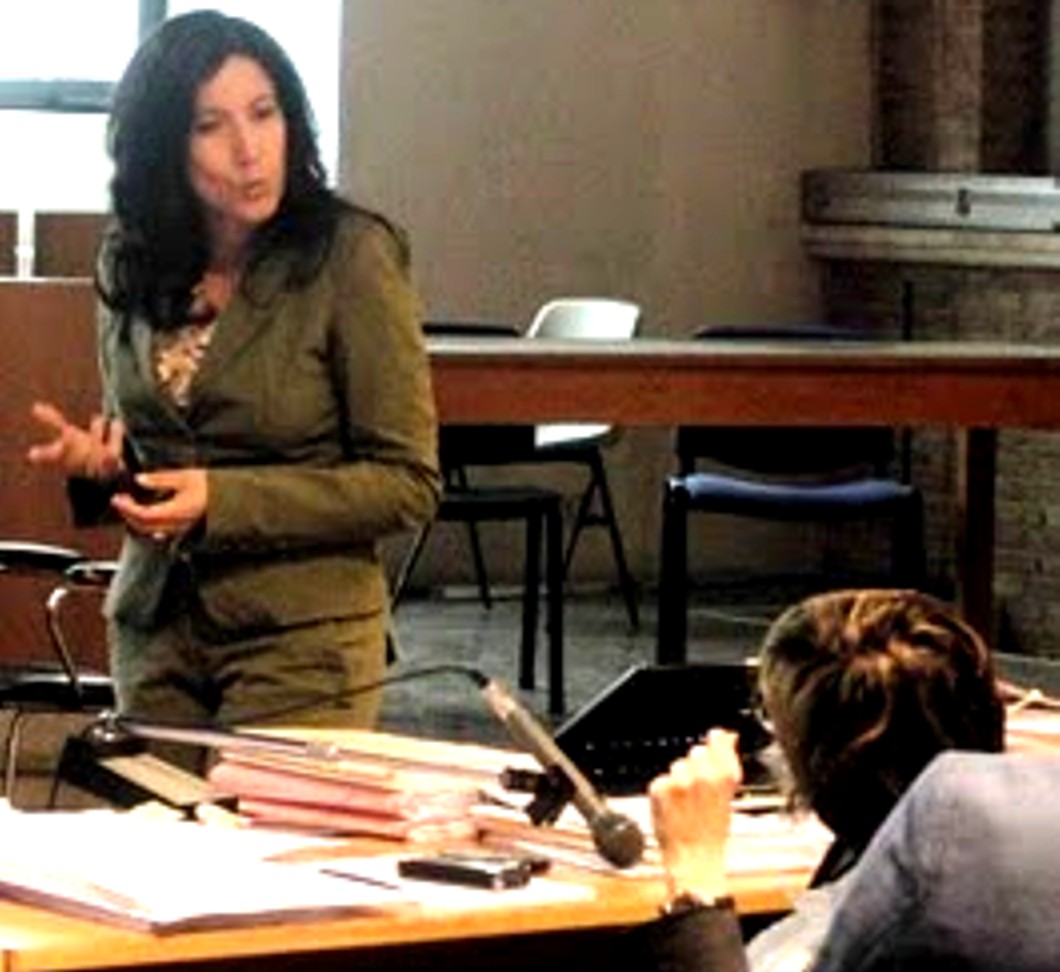
[Above: Dr Stefanoni at trial respoding to a question from Sollecito’s defense team]
Amanda Knox and Raffaele Sollecito and their families were jubilant at Judge Claudio Pratillo Hellman’s decision to allow an independent review of some key forensic evidence.
Two experts from Rome’s Sapienza University - Professor Stefano Conti and Professor Carla Vecchiotti - have already been nominated by the appeal court (they will be confirmed in January) to do an independent review of the forensic evidence.
Late saturday and sunday many of the journalists covering Meredith’s case saw Judge Hellmann’s decision as a major victory for the defence teams. Several giddy journalists even reported that somehow Amanda Knox had won her appeal.
However, two very important facts were lost in all the hullaballoo surrounding Judge Hellmann’s decision about this independent review..
First, the original forensic investigation and tests already were carried out by independent experts. Dr. Stefanoni and her team were from Rome, and they worked for another arm of the government. They weren’t hired by the prosecution to blindly confirm their suspicions that Amanda Knox, Raffaele Sollecito and Diya Lumumba were involved in Meredith’s murder.
And many people seem to be unaware of the fact that it was not Amanda Knox recanting her false accusation, but the DNA testing work of Dr. Stefanoni and her team that led to the release of Diya Lumumba. In this case Dr Stefanoni has high credibility.
Second, a number of experts have ALREADY carried out independent reviews of the DNA and forensic evidence and some of them have testified at court hearings in the course of 2008 and 2009.
In this post, we will take a look at some of the experts involved in the original DNA tests and the subsequent reviews and consider the implications of the new review, including some possible unexpected stings in the tail.
1) The Original Tests
Dr. Patrizia Stefanoni is one of the leading forensic experts in Italy and she was part of the the Disaster Investigations Teams sent to identify victims of the south Asian tsumani in 2004. She had to pass a series of stringent state tests to join the scientific police in Rome. She led the forensic investigation into Meredith’s murder and was responsible for carrying out the DNA tests and interpreting the results.
The Double DNA Knife
Dr. Stefanoni found seven traces of human flesh (human tissue cells) on the large kitchen knife sequestered from Sollecito’s kitchen. There was only enough DNA for one test. However, the results of non-repetitive tests are allowed to be entered as evidence in Italy.
The defence teams are notified of the date and time of all non-repetitive tests to make sure that they can be present to observe that correct procedures are adhered to. If they miss the tests or don’t stay for the full (often long) duration they have not carried out their full mandate to their client (they might even be liable for malpractice) and the defense has no right to claim wrong procedures or lab contamination.
Dr. Stefanoni testified at the trial that the one test she did “reliably” identified the DNA as Meredith’s.
Italian TJMK poster and DNA specialist Nicki explained in May 2009 why the DNA on the blade of the knife was a definite match to Meredith’s DNA:
Two genetic profiles are identical and therefore belong to the same individual if a) they are in the same position, and b) they have identical shape and dimension. In this case, each peak produced in the original samples exactly corresponds to the peaks yielded by the knife sample, position, shape and dimension.
[Below: DNA on the blade of the knife(top chart), Meredith’s DNA(second chart), and the two superimposed]
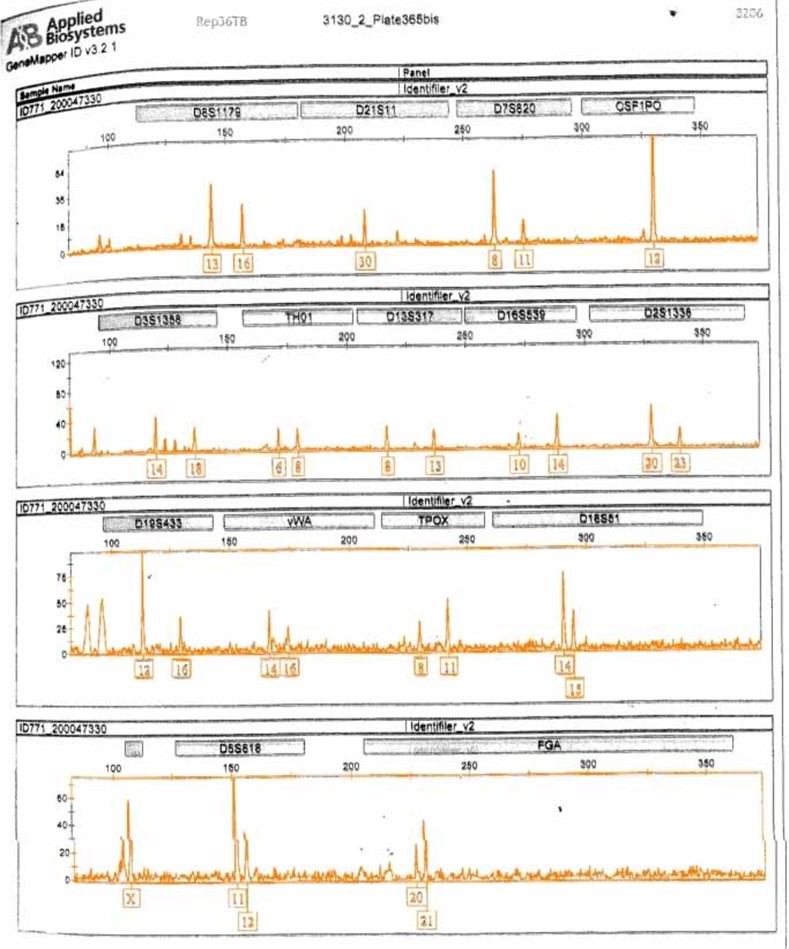
The Bra Clasp
Sollecito’s DNA on Meredith’s bra clasp was identified by two separate DNA tests. Judge Massei rejected defence claims that Sollecito’s DNA was LCN DNA and noted that there was no reason to doubt the reliability of the result:
It has already been said that Dr. Stefanoni had reported that on the [bra] hook (Exhibit 165B) the mixed genetic profile attributable to the victim and to Raffaele Sollecito was found; looking at the electropherogram, the ratio had been estimated in the proportion of 1 to 6 (the victim’s DNA being six times that of Sollecito); the quantity of DNA found could not be considered terribly small because there were several peaks that easily exceeded 1000 RFU, and no [317] repetition of the analysis had been carried out because the peak height of the smaller fraction of DNA was good, such that there was no reason to doubt the reliability of the result.
2) Independent Reviews
Dr. Renato Biondo
There was an independent review of the forensic evidence in 2008.
Dr. Renato Biondo, the head of the DNA unit of the scientific police, reviewed Dr. Stefanoni’s investigation and the forensic findings. He testified at Rudy Guede’s fast track trial in October 2008 and confirmed that all the forensic findings were accurate and reliable.
He also praised the work of Dr. Stefanoni and her team. “We are confirming the reliability of the information collected from the scene of the crime and at the same time, the professionalism and excellence of our work.”
Professor Francesca Torricelli
The Kercher family hired their own DNA expert, Professor Francesca Torricelli, and asked her to examine the DNA evidence.
Professor Torricelli is the Director of a genetic facility at Careggi University Hospital and has been working in genetics since 1976. She testified at Knox’s and Sollecito’s trial last and she also confirmed Dr. Stefanoni’s findings.
She told the court that the significant amount of Sollecito’s DNA on Meredith’s bra clasp meant that it was unlikely that it was left by contamination. She also agreed with Dr. Stefanoni that Meredith’s DNA was on the blade of the double DNA knife.
General Luciano Garofano (image above)
Distinguished DNA expert and former Caribinieri General Luciano Garofano analysed the DNA and forensic evidence for the early 2010 book “Darkness Descending”.
He has more than 32 years of forensics experience and is a member of the American Academy of Forensic Sciences. In his section of the book he explains at length why he too thinks that Knox and Sollecito are guilty of Meredith’s murder.
In an interview with The Sun’s Nick Francis, he said that the right people had been convicted: “I believe the police have prosecuted and convicted the right people, even if they got some of the details wrong.”
He told reporter Andrea Vogt that there wasn’t enough evidence to overturn Knox’s and Sollecito’s convictions: “I do not believe that there is enough evidence to convince an Italian magistrate and jury to overturn this conviction”.
Dr. Anna Barbaro
Rudy Guede’s defense lawyers hired their own forensic expert, Dr. Anna Barbaro, and asked her to examine the DNA evidence.
She didn’t dispute the DNA evidence against Guede, Knox or Sollecito. Guede’s lawyers claim that there was an innocent explanation for his DNA being at the crime scene and that Knox’s and Sollecito’s DNA implicated them.
Guede lawyer Walter Biscotti noted that the evidence against Knox was particularly strong.
3) The original prosecution team
Both Prosecutor Mignini and Prosecutor Comodi said after the appeal session on saturday that they are are confident that the independent review of the DNA and forensic evidence will confirm the sentences and verdict.
Mr Mignini
:
I don’t agree with the request and I see it as a waste of time. The judge did not criticise the methods that were used to collect and test the DNA….. The review was granted because the jury needed help to interpret the findings as they are difficult to understand. I don’t see how it is a victory for the defence, as the methods were not criticised in the ruling. The review will confirm the sentence and the verdict will stand.
Ms Comodi
As far as I am concerned this independent review will just confirm the excellent work carried out by the police scientific unit. The judge did not actually explain why he was allowing this review and although I do not agree with it I am sure it will underline the job originally done.
4) Two possible game-overs
Re-examination of the knife
In “Darkness Descending” the former Carabinieri General Garofano wrote that the police should have separated the plastic handle from the knife and checked for blood there.
The defence teams will regret having asked for the independent review if the new experts do this and they find there a testable quantity of Meredith’s blood.
Re-examination of the bra clasp
According to the authors of “Darkness Descending” Dr. Stefanoni found highly suggestive evidence of Amanda Knox’s DNA on Meredith’s bra. Raffaele Sollecito’s forensic expert, Professor Torre, also claimed that he had found Knox’s DNA on Meredith’s bra strap.
It seems that another forensic expert Vincenzo Pascali ALSO found Knox’s DNA on Meredith’s bra. The reporter Barbie Nadeau wrote the following:
Vincenzo Pascali, the chief forensic consultant who was set to give expert testimony about the possible contamination of the bra clasp, walked off the case last month, reportedly leaving a €50,000 bill. Back in September, Pascali, who declined to comment for this story, hinted that the clasp also contained Knox’s DNA.
And so in conclusion
One to two years later DNA testing techniques have improved, and also there is the sleeper of what is under the handle of the knife.
The defence teams’ insistence on an independent review could really explode in their faces if the new experts confirm more of Meredith’s DNA on the knife (Knox’s DNA is there very strongly) and that Knox’s DNA is on Meredith’s bra.
Saturday, December 18, 2010
First Reports On Scope Of Appeal Sounds Like Maybe A Setback For The Defenses
Posted by Peter Quennell
The first full reports are not out yet. This is a first quick take on the Italian reporting and may be subject to correction.
Some of the Cassation’s hard-line decision for rejecting Rudy Guede ‘s 10 appeal grounds in Rome on thursday will indeed be accepted into this appeal for the judges’ consideration.
The judges are agreeing to the defense request for a review of the testing of the DNA on the bra clasp and the large knife, though of course nobody - nobody - so far has ever proved contamination as the prosecutors today pointed out.
Two Rome experts in DNA have already been nominated.
Apparently none of the other very extensive forensic evidence at the scene of the crime - which is the entire apartment, not merely Meredith’s bedroom - is to be retested. That has always been very tough to explain away.
Apparently only one or two of the previous witnesses whose testimony is described in the Massei report will be heard from again. Possible Guede confidant Alessi will be allowed and maybe Aviello who claimed his missing brother really did it.
And apparently ninety days is added to the allowed duration of this appeal, because the Massei Report took 90 days to produce. The deadline now is next September, although if it lasts through to the spring we will be surprised.
The defense doesn’t seem to have many strong hopes going forward. No more Spiderman attempts on Filomena’s window. They found no room for appeal with regard to the various contradictory alibis, the various peculiar phone calls, and assorted bizarre behaviors.
Remember that even Knox and Sollecito themselves have claimed they were zonked out of their skulls on the night - though magically they seem to have managed a major cleanup and rearrangement of the entire crime scene, minus evidence pointing to Guede.
The astute commenter Piktor posted this on PMF
The expert review would be needed if the scientific results were the only evidence that convicts.
What if the DNA evidence was thrown out. Could you convict without it?
You have the staging, the lies, the false accusation, the police testimony, the defendant’s multiple alibis that don’t mesh, Mrs. Mellas testimony in court exposing Knox’s willful “confusion”, the email and diaries.
You add it up and it all points in one direction. No doubt about the result.
The prosecution narrative makes sense. The defence has no narrative.
The Appeal’s Set Limits: What The Judges Allowed Today And Didn’t Might Tell Us A Lot
Posted by TomM
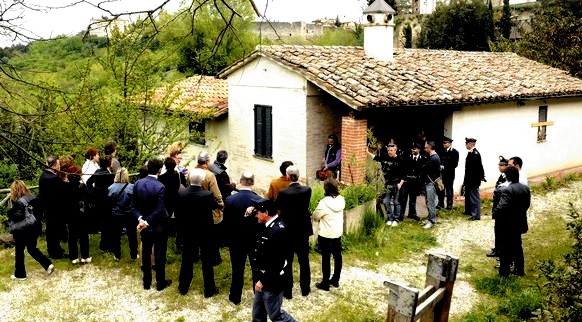
[Massei court deciding whether to buy spiderman theory; they didn’t]
1. The Context Of These Remarks
The judge ruled on the appeal’s inclusions and exclusions today. I’ll summarise what they are and how American courts might have differed.
I really do not understand why the defense and the family are so happy with this review, which is very limited and not complete in any sense - other than, perhaps, the “any port in a storm” phenomenon.
From my view in the bleachers, there are way more risks to the defense than to the prosecution from Saturday’s rulings.
2. What’s Allowed In Italian Appeals V. American
As a California lawyer familiar with trials and appeals in my state, watching the Meredith Kercher murder trial wind its way through the Italian legal system has been a learning experience.
It is a system with more protections than the one I know first-hand. The case is now in its first appeal phase, and proceeds far differently from the way it would in the US.
- If Knox and Sollecito had been convicted in an American court (which an American court would have had no difficulty in doing) less helpful presumptions would be applied to their appeal.
- In Italy they are convicted, and for that reason they are imprisoned and the visitation privileges they had before the jury’s verdict have been reduced. But for purposes of weighing the evidence in the appeal, they are presumed innocent.
- In the US, the court of appeal would not presume them innocent or guilty; it would regard them as having been adjudged guilty.
- In Italy, they can ask for the court of appeal to hear testimony from new witnesses and seek to introduce additional evidence.
- In the US, the appeal would be on the basis of the clerk’s and reporter’s transcripts of the trial. In the US the jury at the original trial would have been instructed that if an item of evidence can be interpreted two ways, one favoring guilt and one favoring innocence, they should accept the interpretation that favors innocence. But not so on appeal; the court of appeal would interpret all the inferences from the evidence in the light most favorable to the prosecution.
- An American court of appeal would not consider an attack on the credibility of a witness unless the testimony was such that no reasonable person would believe the testimony.Thus, an attack on the testimony of Curatolo would have no chance of success on appeal. In fact, jury instruction in the US would give the jury blessing to believe him even absent disco buses running that fatal night.
From a form jury instruction on how to judge witness credibility:
“Do not automatically reject testimony just because of inconsistencies or conflicts. Consider whether the differences are important or not. People sometimes honestly forget things or make mistakes about what they remember. Also, two people may witness the same event yet see or hear it differently.”
The Italian appeal is described as a “trial de novo”.
- In common law jurisprudence, a trial de novo is simply a new trial, and the jury in a new trial would not even be told of the existence of the first trial. It would be done as if the first trial never happened.
- Not so in Italy. The jury and lay judges have full access to the case dossier, the Massei Motivazione, and the briefs of the parties. They decide which parts of the case should receive new evidence, and the parts where none is needed. If that were not the case, they would not know how to respond to the defense requests.
3. Tellingly, What Court Has NOT Re-opened
1. Staging Of Burglary
It is significant that there is no re-visit on the staging of the burglary. This charge is not just one of the things used to prove the murder, it is also a separate charge which does not require that a person also have participated in the murder.
Let’s suspend disbelief a moment. Suppose AK and RS had not been present during the murder, having ducked out briefly to get more drugs, but returned to discover Meredith’s body.
Suppose they thought they would be suspects because they had let Rudy in and feared they would be blamed, so they staged the burglary to divert suspicion from themselves. In this hypothetical situation, they are still guilty of staging a burglary even if they didn’t otherwise participate in the crime.
So, what to make out of the fact that no further evaluation will be made of the staging?
This seems like the easiest of the charges to prove and the most difficult to defend. Staging is a recognized phenomenon in criminal investigations and the defense expert did not fare well under cross-examination. I don’t see how the court would reverse the judgment on this issue given the state of the record.
2. Collection Of DNA
Defense criticized the way the dna was collected from the bidet, but there will be no review of that evidence - or of any other of the mixed blood/dna evidence - only the knife and the bra clasp.
If the appellate jurors’ inclination were to think there is reasonable doubt on the dna, there is plenty of defense expert testimony to hang that hat on. That only two of the exhibits will be studied shows that they do not question the work of the scientific police as a whole.
4. The Pattern Of Sorts In These Rulings
From my own experience, I firmly believe that Hellman has not made up his mind on the final outcome. That doesn’t mean he doesn’t know what he thinks the jury will do with the case.
He clearly knows the case, and I think he knows if there are areas in Massei’s reasoning that have vulnerabilities (not necessarily fatal) that could attract attention in the Court of Cassation.
I think he knows whether the prosecution’s case is a house of cards, or if it is a good case with some curable cosmetic flaws.
To me, the rulings look like the judge has reviewed the case, thinks it is fundamentally sound, and believes it will be backed up by unbiased expert opinion - and if it doesn’t, he will assess what impact that has on the case.
The issue with respect to the scientific police is not that they were biased in the sense of falsifying evidence to wrongfully convict, but that the video of the crime scene investigation showed non-textbook acts, Stefanoni didn’t leave a complete paper trail in testing the knife, and they failed to collect and correctly bag the bra clasp at the beginning.
All of which left an opening for the defense to claim the dna evidence is suspect. There is a reason why teachers don’t let students grade their own papers, I think that concept is behind Hellman’s decision to seek an unbiased review of these two items.
5. No Signs Of Exoneration In Rulings
If Rudy Guede testifies and gives a believable narrative, it may not matter what the two dna reviews say, and it might also undermine the jurors’ inclination to accept the theory of remorse from the covering with the quilt that persuaded Massei to reduce the sentence.
An increased sentence is not out of the question.
As I said at the top, I really do not understand why the defense and the family are so happy with this review, which is very limited and not complete in any sense - other than, perhaps, the “any port in a storm” phenomenon.
The bra clasp evidence is not going to go away, and there is the risk that increased technical sophistication could result in identifying a complete dna profile of Amada Knox on it. If they disassemble the knife, there could be abundant blood between the handle and the blade.
Again, from my view in the bleachers, there are way more risks to the defense than to the prosecution from Saturday’s rulings.
Friday, December 17, 2010
Stinging Guede Final Appeal Rejection Suggests Trouble For Knox and Sollecito
Posted by Peter Quennell
Rudy Guede’s appeal is rejected on all ten grounds.
His appeal grounds were ugly and dishonest and he has no further appeal. He will serve his 16 years, with maybe some time off, for being a savage willing party to the cruel stupid murder of Meredith.
Rudy Guede will go down in infamy for his sex crime against a defenseless victim, for being a party to a taunting torturing knife attack, for claiming Meredith invited him in for consensual sex, and for not calling for help for Meredith and maybe saving her life while it was still possible.
Cassation continues the fine Italian court tradition in this case of taking a firm and unblinking position, and for being utterly oblivious to the vile over-the-top campaign of Curt Knox, Edda Mellas and David Marriott which may now haunt Amanda Knox all of her life..
This is clearly not a final court of appeal that is now going to turn on a dime and say when they hear the final appeals of Amanda Knox and Raffaele Sollecito, oh, of course, we got that previous decision wrong, and of course Guede did it alone.
Here is the cool clear report of Andrea Vogt, this time being published in the UK’s First Post. The highlights:
1) On rejecting Guede’s ludicrous tale.
Put simply, no judge or magistrate has believed Guede’s story that he was in the bathroom of the apartment the two girls shared in Perugia, listening to music on his iPod while someone else stabbed Meredith.
According to Guede’s story, when he came out of the bathroom he found Meredith bleeding to death and tried to staunch the flow of blood ““ hence the discovery of his DNA by investigators.
2) On the huge new risk now for Sollecito and Knox.
Under Italian law, all documentation from Guede’s various hearings can now be introduced into the appeal trial of Knox and her former boyfriend, Raffaele Sollecito, which reconvenes in Perugia tomorrow.
The problem for Knox and Sollecito is that Guede’s trial documents will include the judges’ reasons for convicting Guede and denying his appeals: namely, that they believe all three ““ Guede, Knox and Sollecito - killed Meredith together.
3) On Kercher family lawyer Maresca possibly demanding Guede testify
“Guede can now be called to testify and we are considering, along with the prosecutors, if we will request that Saturday or not,” said the Kercher family’s attorney Francesco Maresca in Rome.
“We will ask that the high court decision be admitted, as it stabilises the facts and is an important point of reference, with judges confirming the reconstruction of events and the involvement of the other two suspects in this dramatic ordeal in which a young woman lost her life.”
If Guede is called, it is unclear whether he would be considered a reliable witness given that no court has believed his story so far. And the situation is further complicated by conflicting stories about Guede’s take on Knox and Sollecito.
4) On the prospects for requested defense witnesses Alessi and Aviello
Guede is also the subject of a mysterious 10-page letter from prison, written on blue notepaper in the feathery script of convicted child murderer Mario Alessi, and now sitting in a lawyer’s office in Parma.
Alessi claims to have heard the real story of what happened while stuck in a prison cell across from Guede. Three other inmates signed each page of Alessi’s letter bolstering his story - that Guede said repeatedly in his cell and the prison yard that Knox and Sollecito had nothing to do with the crime. (Guede denies the conversations)...
Will the judge overseeing Knox and Sollecito’s appeal in Perugia request it? If he does, it could be entered into evidence alongside further controversial letters, these from a Neapolitan mafia snitch named Luciano Aviello. Aviello claims that his own brother killed Kercher…
Since Knox and Sollecito were convicted and jailed a year ago.. these stories of intrigue have found their way out from behind the prison walls across Italy, from the sex offender ward in Viterbo to the high security penitentiaries in Prato and Turin.
5) And on John Kercher’s recent strong protest against the profiting from Meredith’s death
Meredith Kercher’s bereaved family this month broke a three-year silence to speak out against Knox’s “minor celebrity” status and the high-profile publicity campaign her family and supporters have been waging to claim wrongful conviction.
Tuesday, December 07, 2010
Andrea Vogt Provides Heads-Up On What May Happen In The Appeal
Posted by Peter Quennell
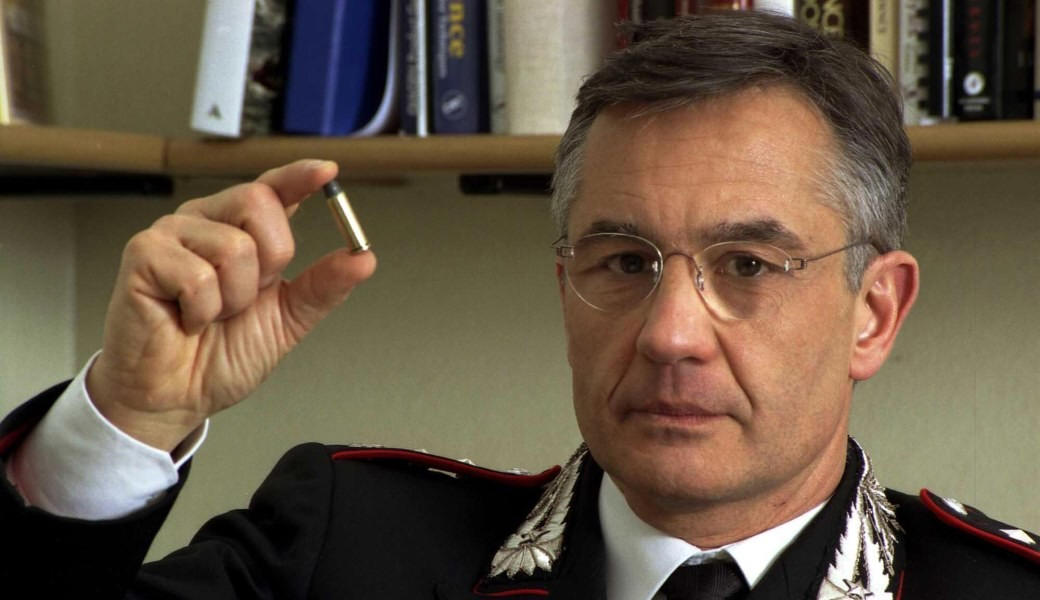
Luciano Garofano created Carabinieri DNA labs; quote below
Update On Pending RS And AK Appeal
Another of the many very informative reports that have appeared on the Seattle PI website.
A mild qualification up front is that we would have liked it mentioned that the prosecution have also initiated an appeal, to throw out the “mitigating circumstances” outlined in the Massei Report.
A reversal on the mitigating circumstances, which we too have always found problematical, could result in all three serving longer time. What the prosecution will come out with in that phase is a real sleeper in this appeal.
1. On John Kerchers article protesting the over-the-top PR campaign
The Kerchers have maintained their silence since their daughter’s murder, even as Knox’s parents appeared on national television in the United Kingdom, the U.S. and Italy. But that could change, as negotiations are under way with at least one national network to hear the Kerchers’ side of the story.
Correct and accurate. More on Meredith would be so welcome to an American audience. We reposted John Kercher’s hard-hitting article here in English and (as the Italian media mostly don’t yet know about it) here translated into Italian.
Biased reports like those of the ill-researched Nikki Batiste of ABC, which mis-stated and ridiculed John Kercher’s claims, omitted to say what Andrea Vogt says: this is THE FIRST TIME that John Kercher has gone public, in an attempt to stop the depraved multi-million-dollar deluge.
2. On the chances of an overturn of the December 2009 verdicts.
American pundits are quick to predict Knox could walk, but Italian legal experts say the chances of completely overturning her conviction aren’t good. More likely, they say, are the prospects of a sentence reduction.
“The Knox trial is one of the few, in the history of Italian criminal justice, in which over 25 judges have agreed—at different stages—on the adverse impact of the collected evidence against the positions of both Knox and Sollecito. In this respect, the case is rather unusual, as Italian justice is often characterised by conflicting decisions of courts on the same case,” said Stefano Maffei, an Oxford-educated professor of criminal law in Italy interviewed by seattlepi.com.
“What I can confirm is that courts of appeal are generally more lenient than courts of first instance, and I would not be surprised if the decision on appeal could bear a lower sentence for both defendants.”
The point is made up at the top here that this report does not mention the appeal of the prosecution for tougher sentences , which would seem to effectively balance out the probabilities that Mr Maffei and all the defenses now claim.
The sheer number of judges that all of them agreed on the evidence in this case is particularly damning. Our own Italian lawyers between them know of ZERO cases where so many judges in succession have found no reason to reverse any part of the process.
We have posted a number of good descriptions of how the Italian process actually works (these go beyond the descriptions in ANY British or American reporting, another sign of how sloppy it has mostly been), and our key posts can be seen here and here and here.
3. On the requested defense witness Mario Alessi
In a file tucked neatly under a polished glass paperweight in Laura Ferraboschi’s Parma law offices is a carefully guarded letter that Knox and Sollecito hope will set them free.
It is 10 pages, handwritten in the small, tilted script of Mario Alessi, a convicted murderer who had the prison cell across from Rudy Guede in the sex crimes ward of a tough prison just north of Rome….
Alessi mailed his statement to her for safekeeping after becoming concerned it might “disappear,” she said…. Sollecito’s lawyers, eager to have the letter at their disposition, asked Ferraboschi to share it, but she has refused, saying she did not feel it would be ethical to do so.
“Alessi sent the statement to me for protection, and I do not feel it is appropriate to give it to other lawyers who might drag him into a case that could negatively impact him,” Ferraboschi said. “If a judge requests the statement or his presence, then we will provide it.”
Good luck on that one. We doubt Alessi ever makes the stand. Here is our most recent post on Mario Alessi which links back to several that went before.
Prosecutors Mignini and Comodi also interviewed Alessi. They have not yet made public what he said.
Investigators and prison staff would have checked Alessi out very carefully. Laura Ferraboschi seems to be hanging firm on not sharing the letter, out of concern that Alessi could incure a charge of perjury.
4. On the requested defense witness Luciano Aviello
The second series of jailhouse “revelations” are from Luciano Aviello, a Mafia turncoat from Naples who shared a cell in Terni with Raffaele Sollecito. Knox’s lawyers went to videotape a statement from him in prison near Turin in March, a month after Bongiorno had videotaped Alessi’s statement in Viterbo.
He wrote several letters to the court last year. In the most recent statement, he claims he can prove all three people in jail for Kercher’s murder are innocent. It was his own brother, he says, who killed her. Aviello…
Aviello said his brother killed Kercher in a robbery gone awry, then asked Aviello to hide a bloody knife and set of house keys. Kercher’s set of house keys have not been found.
Good luck on that one too. We doubt that Aviello too ever makes the stand.
In our most recent post on him here we remarked that, with this guy, the defense was already seriously grasping at straws. We are amazed that they still want to wheel him out. That weak move does not bode well for Knox and Sollecito.
5. On the requests for more testing of the DNA
Repeatedly, judges have rejected defense arguments about the forensic evidence despite the slipshod way it was processed and Italy’s reputation of lagging behind the rest of Europe in DNA certification, handling protocols and databasing.
Many outside observers believe the court should allow for such an independent review, given the number of protocol mistakes revealed in the first trial.
Defense attorneys and their expert witnesses heavily criticized the work of police biologist Patrizia Stefanoni and the Perugia and Rome forensic teams working under her direction for such missteps as not changing gloves after picking up evidence, poor collection methods and incomplete records of how evidence was handled and in what exact order during later laboratory testing….
Two of the primary pieces of evidence against Knox and Sollecito are highly contested: A bra clasp originally catalogued in the first days after the murder that was picked up in a sweep of the crime scene 46 days later, and the kitchen knife with Knox’s DNA found on the handle and the victim’s DNA found on the blade. The bra clasp is said to contain Sollecito’s DNA. The amount of Kercher’s DNA found on the blade was such a trace amount it registered with a “too low” reading when analyzed.
Our DNA section on TJMK is very complete and to a very high standard. The three posts here and here and here are particularly worth a very careful read.
More tests had already been denied by Judge Massei. Defenses tend to like to do this, to keep insisting on more and more testing, until finally with luck an expert breaks their way.
The defense now “highly contests” the testing but they also attempted that throughout the trial and several of their experts under cross-examination had to take a step back.
Experts were invited to the one-time-only DNA testing of the knife and then (surprise, surprise) on the day of testing not all of them showed up.
And on whether Italy lags behind the rest of Europe on standards, see below (Italy doesn’t)..
6. On the standards of the laboratories that did the testing
A top geneticist at one of Europe’s top forensic labs at the University of Salzburg confirmed in an interview with seattlepi.com that it is possible to amplify such a small amount of DNA, as Stefanoni did, until DNA can be identified. But the expert added that it would not be allowable unless the result could be reproduced, something police biologist Stefanoni said under cross-examination could not be done.
The Salzburg geneticist, who does forensic testing for police agencies in neighboring Austria, said that in the university’s certified lab (which has the highest certification available in Germany and Austria) different operators are required to handle suspect and victim DNA and that the various phases of DNA analysis happen in different labs along a “one-way street” to avoid the possibility of contamination.
Such protocols were not in place in Rome. In fact, Italy is noted for being behind on international forensic standards. For example, it is one of the last (and only) European countries to have not yet become part of the Prum convention, which sets basic guidelines for sharing of DNA data and other security information.
The top geneticist at Salzburg University is unfortunately not named, presumably at his request, and there have been so many claims by both anonymous and unqualified self-proclaimed experts throughout this case that we wish he had said that yes, he could be named.
The Rome labs were in fact being operated to international standard and they had followed the European protocols for years. When they were only recently certified to European standards, none of the procedures or the training or the layout of the labs had to be changed.
Perhaps the top geneticist should have mentioned this.
7. And on the views of renowned forensic scientists Luciano Garofano
One of Italy’s top forensic biologists, retired Caribinieri General Luciano Garofano, is at the forefront of the push to introduce a national database and DNA certification standard in Italy. Garofano (a member of the American Academy of Forensic Sciences who collaborated frequently with the FBI over the years as a high-ranking Caribinieri military officer) analyzed the forensic evidence in the Perugia case for a book released shortly after the trial was complete.
He believes Knox was involved in the murder, but he disagreed with the court’s conclusion that Kercher was sexually assaulted—he is convinced Kercher’s death was a fight that degenerated, then later staged as a rape.
Interviewed by seattlepi.com, Garofano said his read of Knox’s appeal was that it was mostly a rehashing of “points that have already been debated…. The knife is a weak element . . . they could argue it should be thrown out because the amount of DNA does not meet international forensic standards. But that still leaves a lot of other evidence,” Garofano said.
“I do not believe there is enough there to convince an Italian magistrate and jury to overturn this conviction.”
Terrific comments. Hard to see why either Knox or Sollecito deserve even the slightest reduction of their sentence. Neither of them has come up with a consistent explanation, both of them seem to have shown some glee, and neither has shown the slightest sign of repentance.
If they tortured and killed Meredith in a particularly cruel and barbaric way, as it seems, then they both seriously need to serve the time.
Monday, December 06, 2010
Will Sollecito And Knox Finally Want To Take The Stand? Why Our Betting Is Against
Posted by Kermit
The Massei Report makes nothing of the fact that Amanda Knox and Raffaele Sollecito did not rise under oath in their defense.
But if that made zero impact on the perceptions of the judges and lay judges, we would be very surprised. There are VERY few cases in the US or Europe where an INNOCENT defendant (1) rose to testify, (2) was then found guilty and sentenced, and (3) and was later found to be innocent after all.
Raffaele Sollecito never ever took the stand. He confined himself to some spontaneous remarks not under oath which is permitted in Italian courtrooms. They seemed not at all effective and they sure didn’t eliminate at all the 80,000 pound gorilla of evidence that the prosecution had let loose in the room.
Amanda Knox made similar spontaneous remarks, none of which seemed very helpful - the first was to jokingly explain why her bunny vibrator was always on view in the bathroom that she and Meredith shared.
The Knox testimony seen here was not a part of the main trial - it was offered ONLY to explain why Knox implicated Patrick Lumumba, and under the agreed rules for that testimony, the prosecution’s questioning was very circumscribed and curtailed.
Despite that, Amanda Knox seemed to do herself little real good on the stand, and in her second day there she sounded amused and very callous about the death of Meredith.
Please click here for 150 questions for Amanda Knox which should open in Powerpoint in half a minute. They show how blistering a full-blown prosecution cross-examination really could be.
Actually it could be even tougher. Those questions were assembled 18 months ago - and in the months after, we had the hesitant and nervous defense phase, the very strong prosecution summation, and the implacable Massei Report.
We could probable triple the questions for Knox now, and create a similar list for Sollecito. If he is given the chance to cross-examine the two, Prosecutor Giancarlo Costagliola very well may triple them.
The defenses have very few rounds of ammunition going into this appeal - the anti-Guede witness Alessi is a joke, and the DNA and forensic tests were all done fine the first time and have never been proved - despite all the smoke being blown - to be false or falsified.
So will they or wont they take the stand?
They seem cooked if they do - and cooked if they don’t. Tough call.
Sunday, November 28, 2010
The Knox Team Makes A Loud Blustery Attempt To Put Lipstick On Its Pig Of A Defense DRAFT
Posted by Peter Quennell
The issues they have to confront include the dramatic changes to her stories, a complete lack of any alibi, the staged break-in, the evidence of mixed DNA (hers and the victim’s), and the proven lies about her activity on the morning after the murder. Taking the court of appeal on a magical mystery tour of a missing knife is nothing more than a distraction.
A court can only strive to establish a motive but, if it’s clear that those tried are guilty, then the motive is not the be all end all.
The most important thing about motive is assessing it in order to determine what the risk is, in future, of the offender repeating the crimes and in murder, especially, what the dangers will be to society.
“Motive” is not an element of the crime. Prosecutors prefer to have a motive because it ads to proof of guilt, but it doesn’t need to be proved. “Intent” is not the same thing “motive.” Intent is an element of first degree murder in common law jurisdictions.
So, media coverage causes unfair trials? Those who endured Stalin’s secret trials might be surprised to know about this. Would a complete media blackout have changed any of the evidence used to convict the two young adults?
It’s ironic that Curt and Edda and the FOA complain about the media influencing the judges and jury in this case when they have done their utmost to influence the legal proceedings in Perugia through the media.
Knox on stand
sure hope Knox’s lawyers aren’t hinging their entire case on the possibility of a second knife existing or not. That’s somewhat beyond belief. They have to deal with the knife that does have her DNA on the handle and Meredith’s on the blade. Mocking the judge for introducing a second knife that wasn’t found sounds like desperation.
The other thing they’re apparently focusing on is lack of motive. This too is a mistake. She’s a quirky Seattlite who conducts sing-a-longs in the courtroom at her own murder trial. And you’re going to ask the appeal court to look deeper for a motive?
I agree that attacking the conviction on the basis of a second knife and motive seems incredibly lame. The evidence you cite is a huge hurdle to get over. They don’t just need to score one or two points (they will probably do so) but address many, many inconsistencies. There are so many strands to this particular web they have woven, and some huge holes in it they have to fill in order to be ‘let off’. I would be astonished if this were to happen. The suggested grounds for appeal here make me pity the pair of them. After all this time, this is their best shot? Holy cow. Their parents must be working hard to maintain the facade of optimism…
I sure hope Knox’s lawyers aren’t hinging their entire case on the possibility of a second knife existing or not. That’s somewhat beyond belief. They have to deal with the knife that does have her DNA on the handle and Meredith’s on the blade. Mocking the judge for introducing a second knife that wasn’t found sounds like desperation.
“Problem is, no one ever mentioned that in court. In fact, the existence of a second knife, Team Knox asserts, was never entered into evidence and as such, should not have appeared in the judge’s reasoning for his conviction.”
Mignini mentioned the second knife when he put forward the prosecution’s scenario of what happened that night.

